A Closer Look at the Real Stories Behind the Vietnam War
Among all the conflicts the United States has participated in, the Vietnam War is one of the most controversial. It was primarily carried out as a proxy conflict by the U.S. to end the rapid spread of communism and the Soviet Union’s political influence. With the number of lives lost sitting at about 2.5 to 3.5 million Vietnamese and 60,000 Americans, it was also one of the bloodiest. The dispute went on from 1955 to 1975 – 20 agonizing years which destroyed Vietnam.
The Vietnam Conflict, or the Second Indochina War, separated Vietnam into two factions: North and South. The Soviet Union and other communist allies aided the Northern part. Meanwhile, the South was backed up by anti-communist groups in America, the Philippines, Thailand, and others who later admitted defeat during the Laotian and the Cambodian Civil Conflict. Communism later reigned on in these three states. We know you’re curious to learn more about the Vietnam War, so here, we’ve gathered photos depicting the real story during that time.
1. Dog Reporting For Duty
Although not a military dog, this puppy captured the hearts of the soldiers in this photo. After every harsh thing their eyes witnessed, the dog became an instrument to wash away all those brutalities. Even during an intense time of uncertainty, it seems that love is indeed all around.
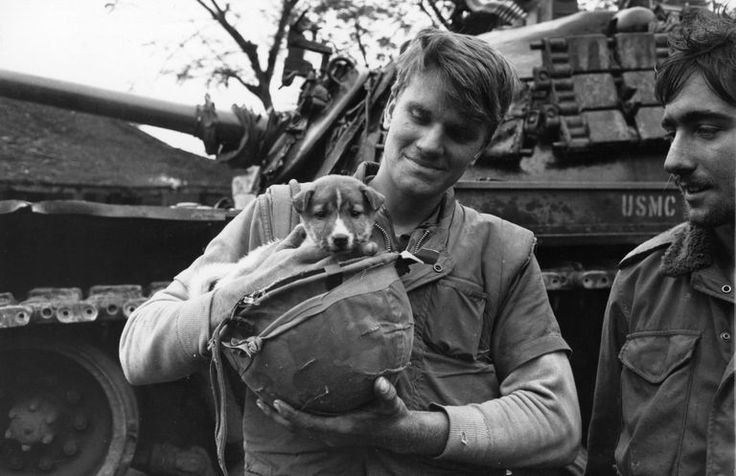
Getty images
Just by looking at these men’s loving eyes and fond smiles, it’s clear that the puppy reminded them that kindness will never cease to exist. Though the elements seen in this image are contrasting, this photo still appears to find the right balance and harmony.
2. Chivalry Still Exists
This is something we all come face-to-face with whenever such conflicts are fought. Not everyone is strong enough to find ways to protect themselves, especially the elderly. In this photo, we are reminded that soldiers can be humane, even in the midst of conflict.
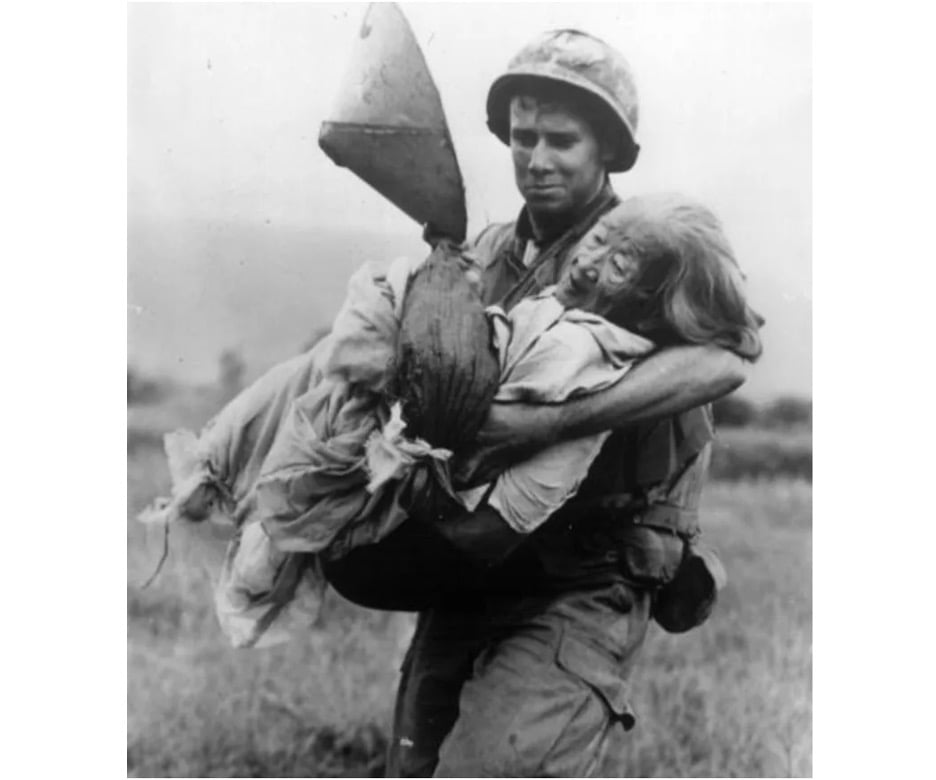
Getty images
In February 1970, a Lance Corporal US soldier was seen going out of his way to carry elderly villagers to safety. Dressed in traditional Vietnamese clothes and barefoot, the poor woman couldn’t otherwise have kept up with the troops.
3. Why Real Soldiers Don't Feel Pain
With their rigorous training, soldiers sculpt themselves to be rugged and powerful. Even after going through severe pain and trauma for long hours, troops in the Vietnam Conflict could do little but endure the hardship. This photo shows a US serviceman trying to put on a bandage for his friend as a temporary measure.
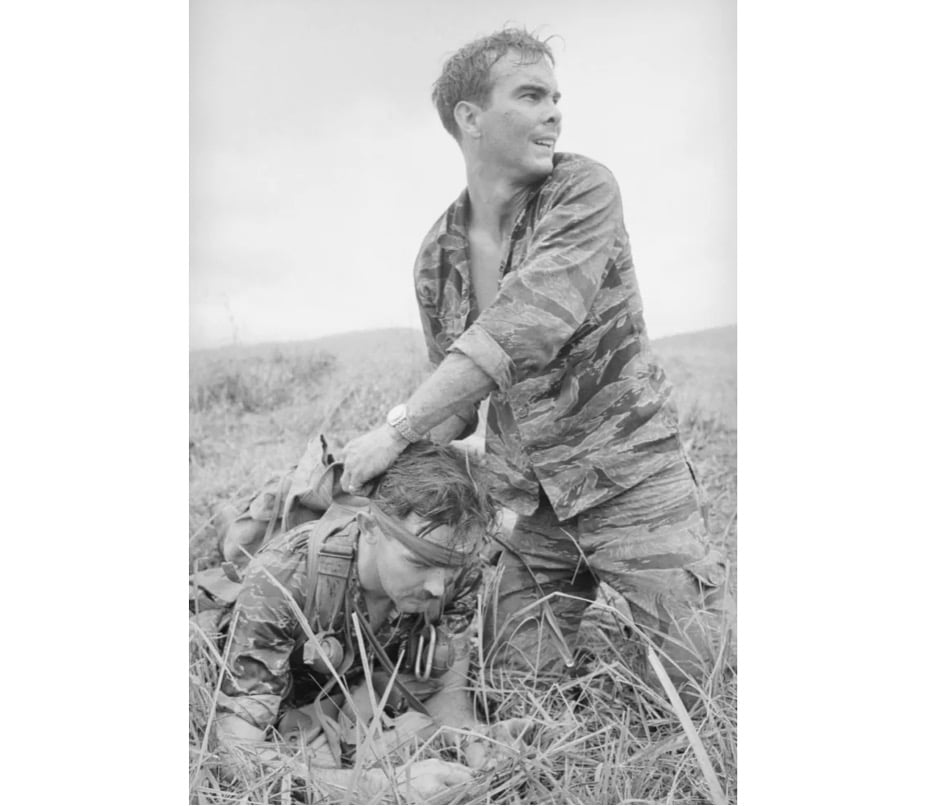
Getty images
The injured soldier looks blank as if he’s already feeling numb with the pain. As a member of the military, it is essential to be resilient if you want to survive. For some of them, human emotions seem like an enemy they should fear.
4. Thanh Tri City
The Viet Cong Guerillas were lacking in terms of their gear and weapons. They didn’t have the best and most technologically advanced equipment compared to their South Vietnamese counterparts. They did, however, know how to put their other abilities to good use.
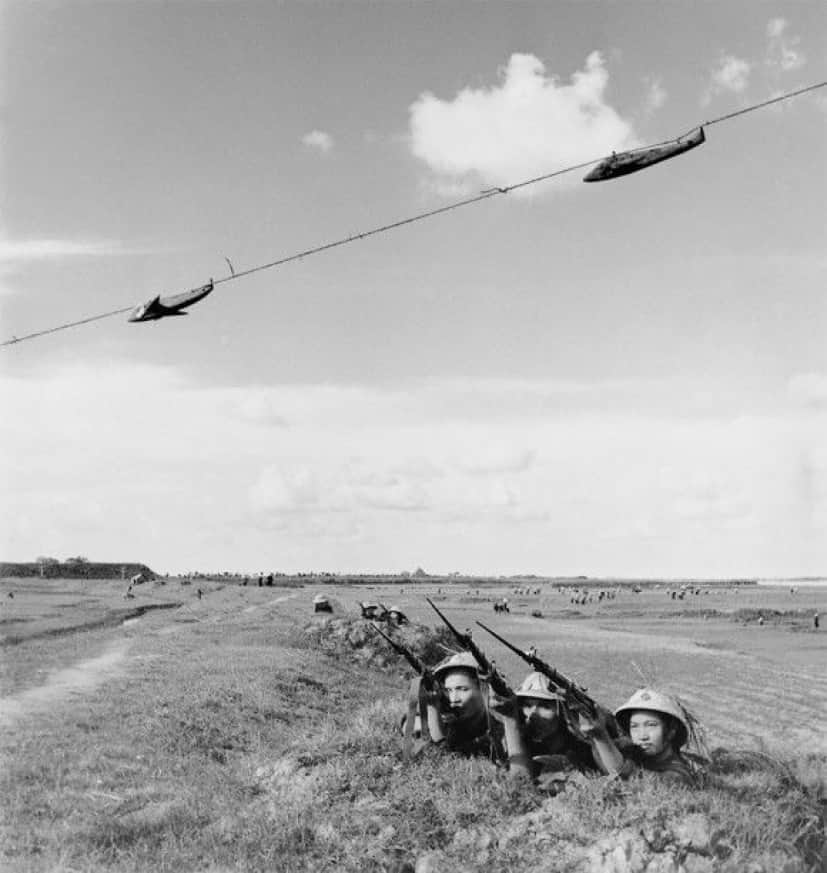
They made life difficult for the US military through their clever tactics and strategies that were hard to predict. Just a few days after having this photo taken, the Viet Cong Guerillas attacked the city of Thanh Tri. This ended up claiming the lives of 25 enlisted men and many innocent civilians.
5. A Village Reduced to Ashes
When the strong forces of the North and South collided, it resulted in chaos. Below is a photo that was taken after a big fight between the two. The US military focused on aerial bombardment attacks. At the same time, the North Vietnamese Army made use of their air force from the Soviet Union.

Getty images
Under the force of all those aerial attacks, which resulted in enormous fires, this village crumbled into ashes. Inhabitants who weren’t able to fight for their lives, unfortunately, met their demise due to the conflict between these two opposing powers.
6. An Unexpected Strategy
Even with a lack of weapons, the Viet Cong guerilla fighters regularly outwitted the Americans. In response, the Americans formulated a strategy called the “Search and Destroy.” They used “Charlie” as a nickname for the guerilla fighters, and they kept a close eye on the wilderness.
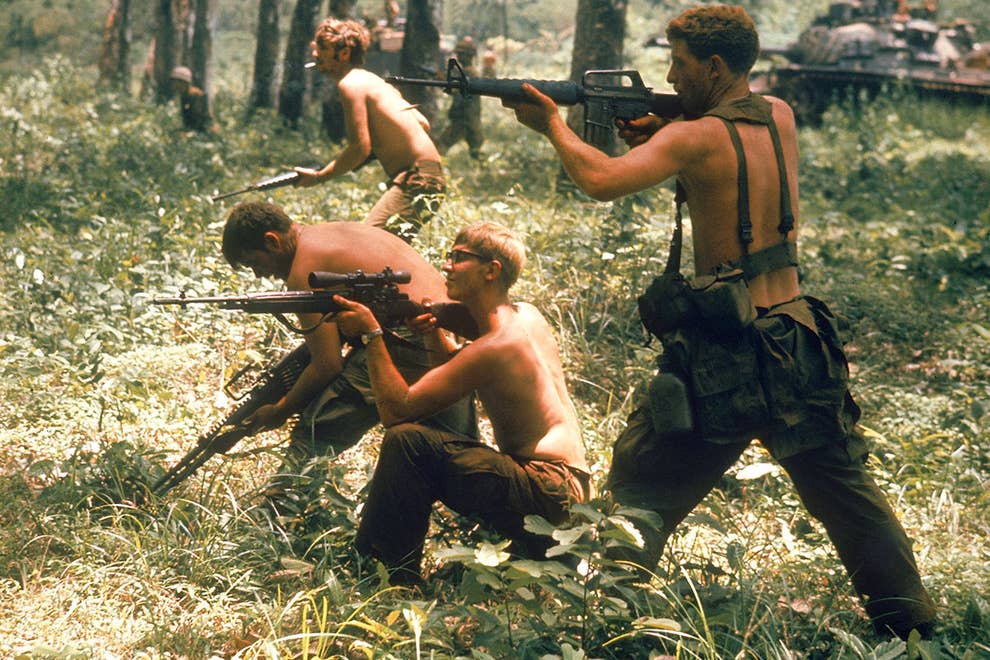
Getty images
Since the Viet Cong’s primary strategy was to be unpredictable, this particular mission required camouflage and dressing in unusual uniforms. The members needed to be efficient and fast to work around landmines and booby traps. However, the only problem was that they couldn’t seem to tell each other apart since they disguised themselves as villagers.
7. Faith in Humanity Amid Chaos
Despite all the atrocities that made both parties fall apart, human decency survived. In this image, a US Marine can be seen offering a bottle of water to quench the thirst of a North Vietnamese prisoner.

Getty images
Despite the horrendous treatment many prisoners receive, random acts of kindness like this give us some hope. The three prisoners from the photo were from the North Vietnamese Army, and after capture, they were taken to a base in the South. Those papers around their necks indicate the date they were captured.
8. The Exhausting Life of a Soldier
Although soldiers are trained to withstand intense battles, we must not forget that they are still human. Every now and then, they get exhausted and drained, not just physically but emotionally. Here in this photo, you can definitely notice how tired this man was feeling.
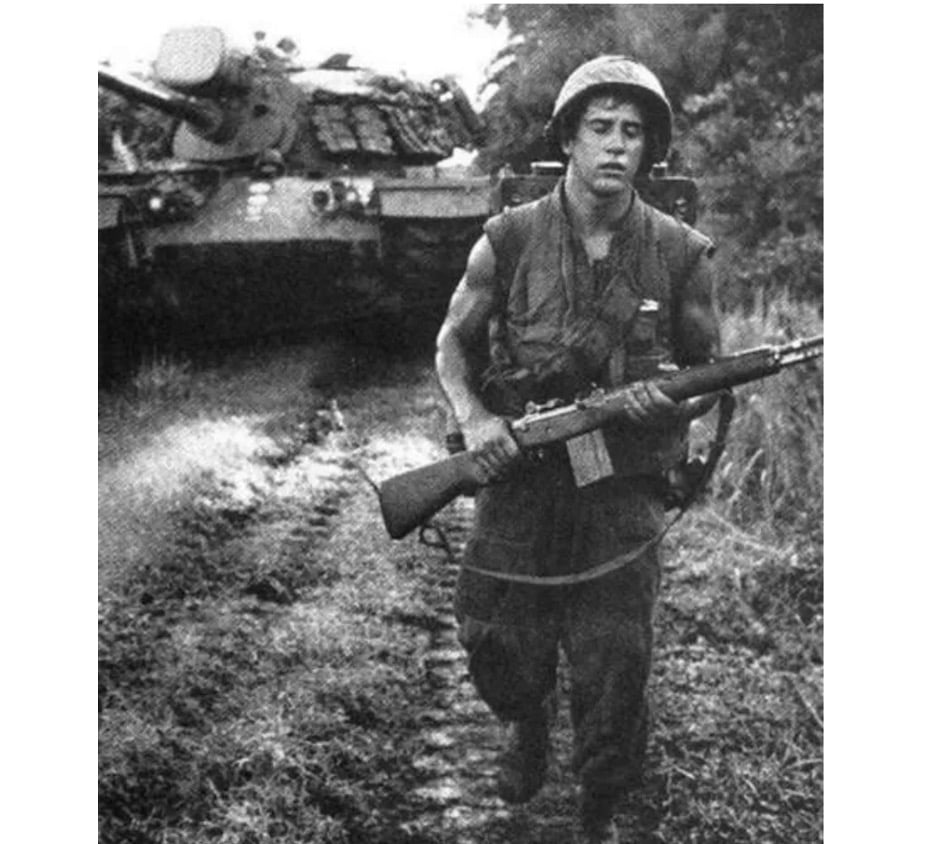
He probably hasn’t slept for days due to the importance of being vigilant at all times. No matter how long you’re in the army, it seems that you won’t ever get used to the exhaustion of conflict. As if fighting wasn’t tricky enough already, troops also had to endure sleepless nights, dehydration, and humid heat that never quit.
9. The Unfortunate Lives of the Children of Vietnam
Statistics show that 84,000 child fatalities resulted from the Vietnam conflict over the years. Children were the most affected by chemical weapons on top of combat and shelling.
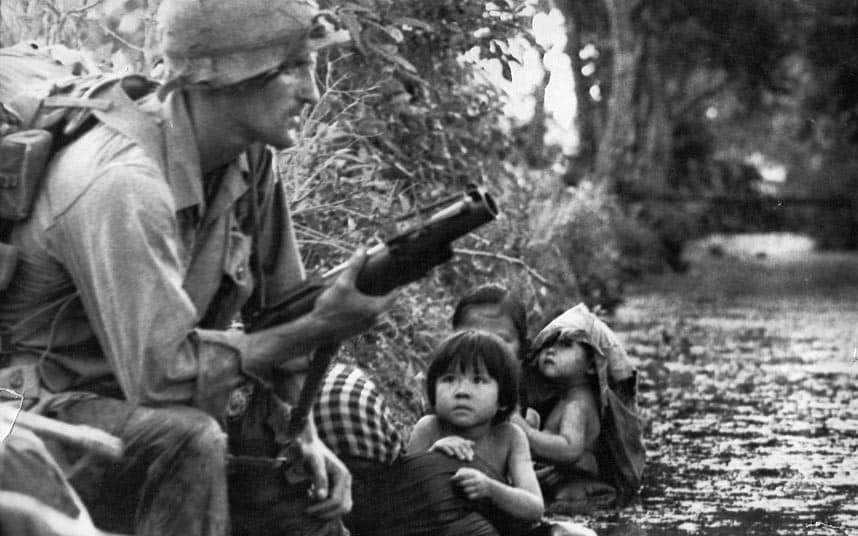
As many parents were away fighting, and quite a few lost their lives, Vietnamese children were often left to fend for themselves. They had nowhere to go because schools had been burnt down and destroyed. While most children stayed hidden, some joined the Viet Cong and the North Vietnamese Army as soldiers.
10. The Loss of Friends
People lose friends and family members when their country engages in conflicts, and soldiers have to witness these brutal losses first-hand. It brings a pain no one can get used to, no matter how frequently it happens. The image below shows those who are mourning the loss of friends in battle.
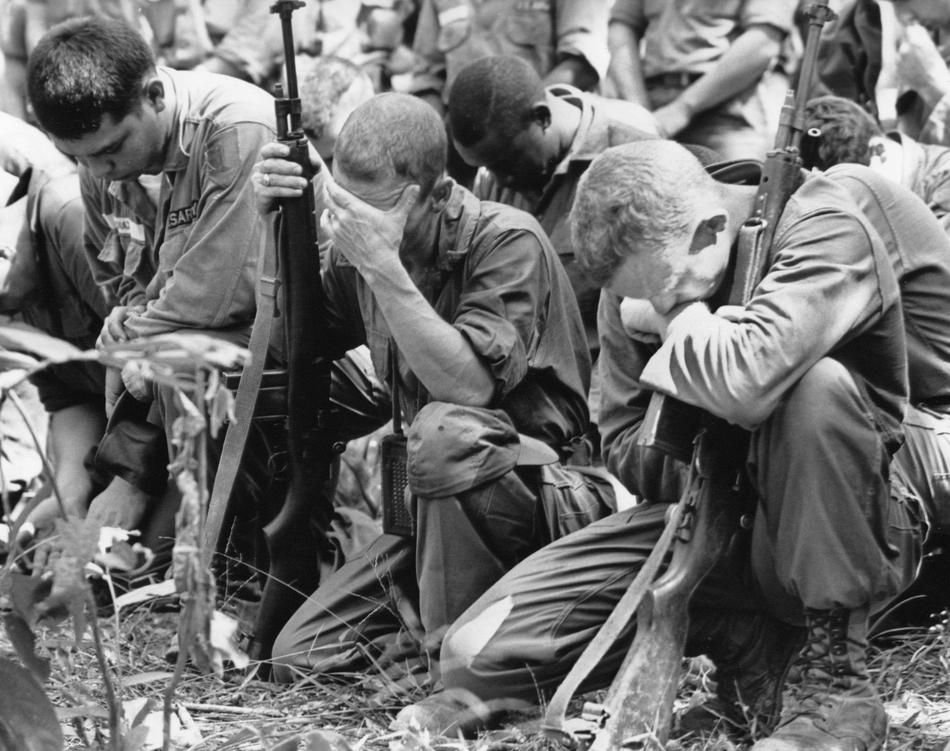
On the battlefield, friendships form over long periods of hardship. These bonds are forged through blood, sweat, and tears. Losing a fellow soldier always leaves an emotional scar on those who remain, which is why we must treat returned veterans with kindness, respect, and understanding.
11. Innocence and Childhood Lost
The photo below depicts a moment in 1967 when two Vietcong kids helped each other light their cigarettes while carrying their rifles. The Viet Cong recruited hundreds of minors to participate in the dispute, as many guerilla armies do.
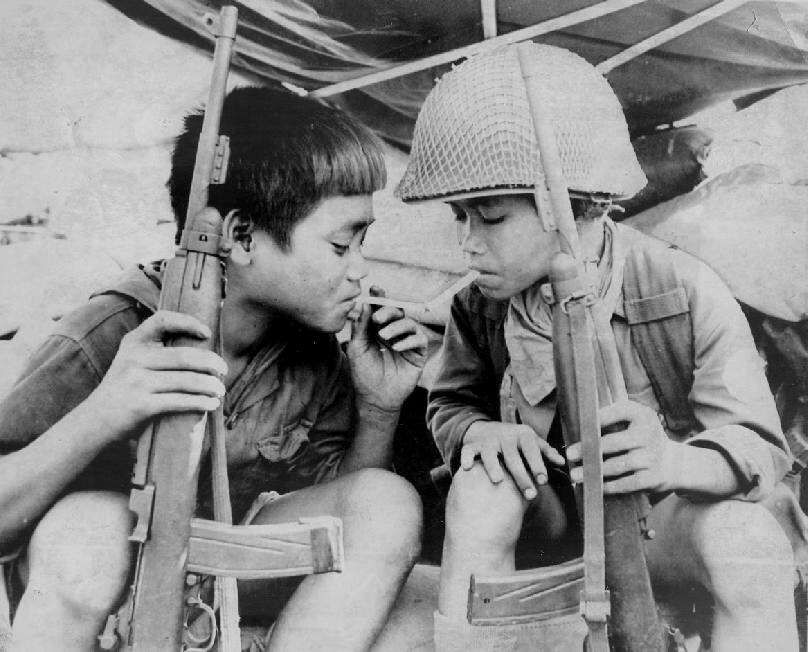
Many children were forced to fight with the Viet Cong, and others joined because they believed in the cause. It is hard to imagine a more accurate representation of the loss of innocence. Once recruited, these boys would be deprived of their opportunity to be happy youngsters.
12. The Mekong Delta Mangroves Masked Activists
This is a rare photo showing female activists during Vietnam. Apart from the masks, it can also be noticed how they are walking barefoot. These women are crossing the Mekong Delta Mangroves using fallen tree trunks as a bridge going to the Nam Can Forest.
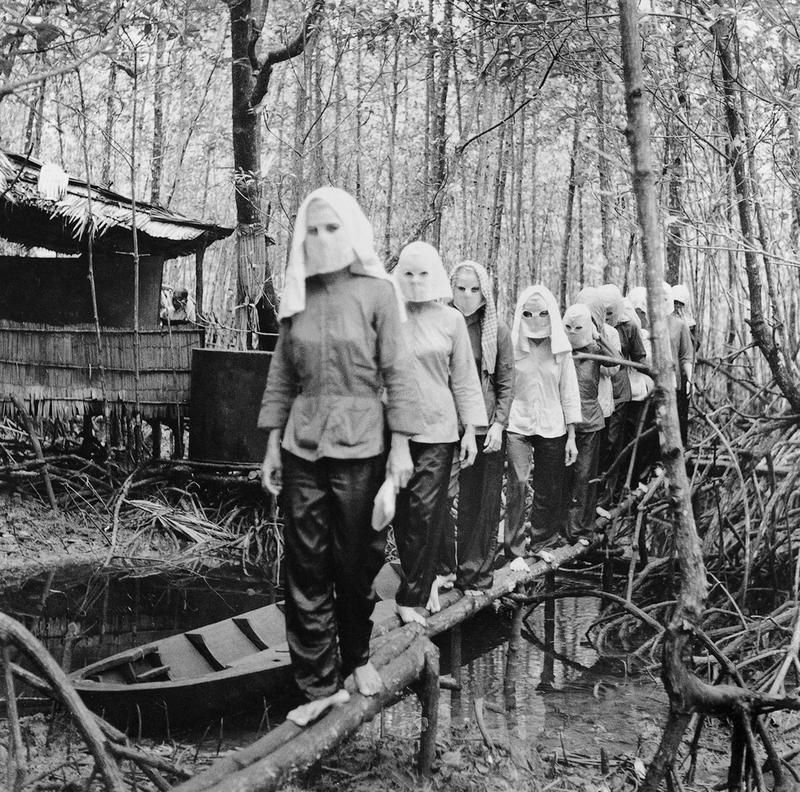
It was said that the meeting was about sensitive war issues, so it was highly secretive. To protect each other’s identity, they all wore masks. They needed to gather in an inaccessible place, so the middle of a mangrove forest seemed fitting.
13. The Tragic Lives of Vietnamese Children During the Vietnam Conflict
Though the precise number of orphaned children is unknown, it is estimated that over 3,000 were left homeless and without guardians. This photograph is a devastating portrayal of one of the conflict’s most terrible consequences: the impact on children.
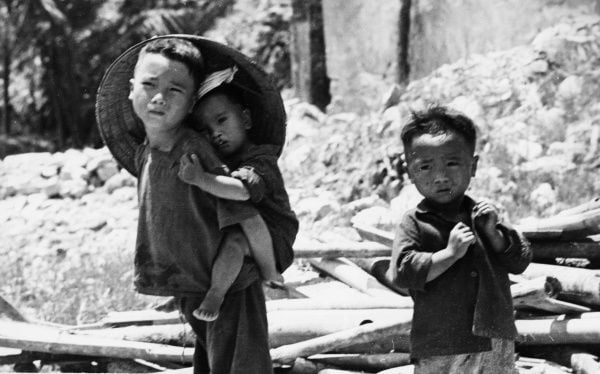
Getty Images
In the early 1970s, these three young North Vietnamese children were left to fend for themselves. The emotions on their young faces are heartbreaking: confusion, immeasurable pain, and exhaustion. Sadly, the conflict wouldn’t end for another five years, and the number of orphaned children would continue to increase.
14. Humanity Still Exists
Staff Sergeant Edgar D. Bledsoe hugs an extremely sick infant in his arms in this heartening photo. The sergeant couldn’t help but feel sorry for the child, who was an innocent victim amidst the conflict.
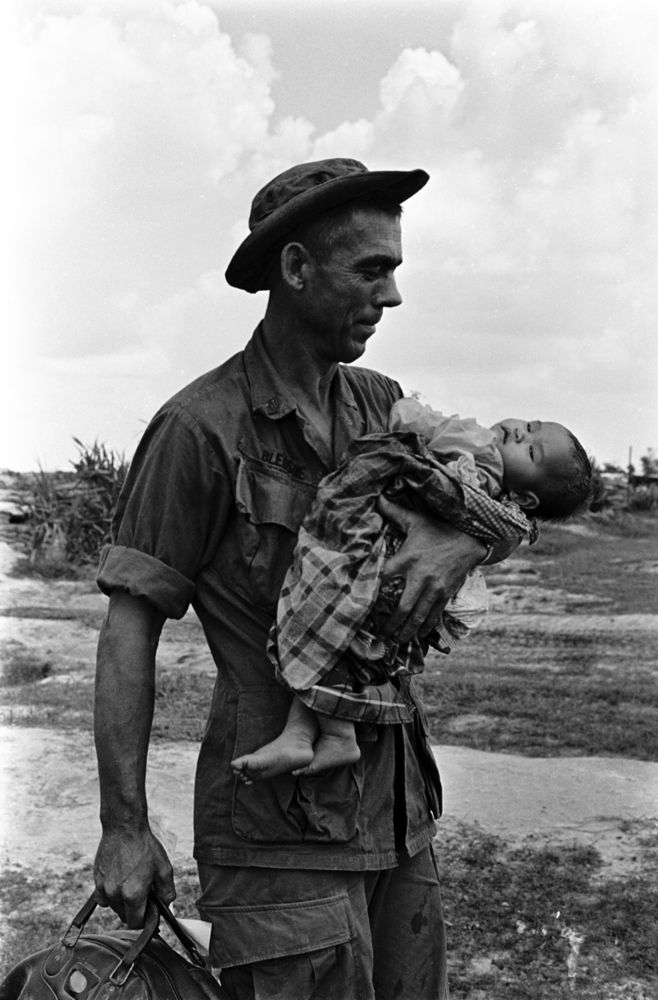
Taking this photograph was part of the job of Charles Haughey. He served in Vietnam as a battalion photographer. Haughey was not allowed to bring his camera into combat, so he took photos to boost the soldiers’ mood after every fight.
15. The Ammunition Supplier
This photo, taken in 1965, shows Nguyen Toi, a militant machine gunner who was seen talking with a 14-year-old boy. The boy was living in a village in Quang Binh Province, situated along the north-central coast of Vietnam. The machine gunner in the Northern province had to protect his region from US planes. This boy, named Truong Huong, provided him with a steady supply of ammunition for that gun.
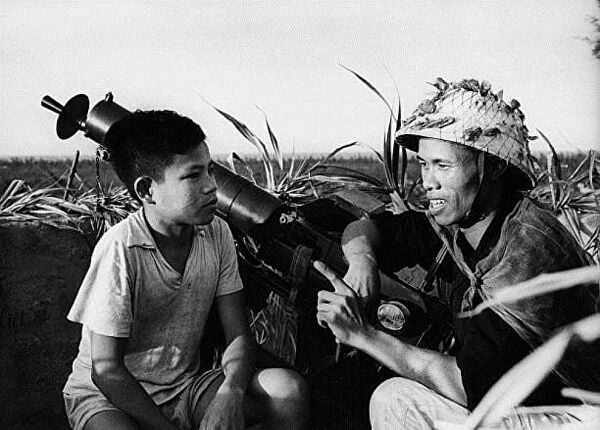
Getty Images
Without the machine gun at his side, this would almost be a touching photo, showing the bond between a man and a boy as they have a friendly conversation on a field. As a matter of fact, when Toi received a Medal of Merit from the Vietnamese National Assembly, the 14-year-old boy received several mentions for his active part in the victory.
16. The Unfortunate Life of Vietnamese Families
With the conflict going on for years, many people lost their families. The men were assigned to take part in the conflict, while the women and their children had to protect themselves from the crossfire.
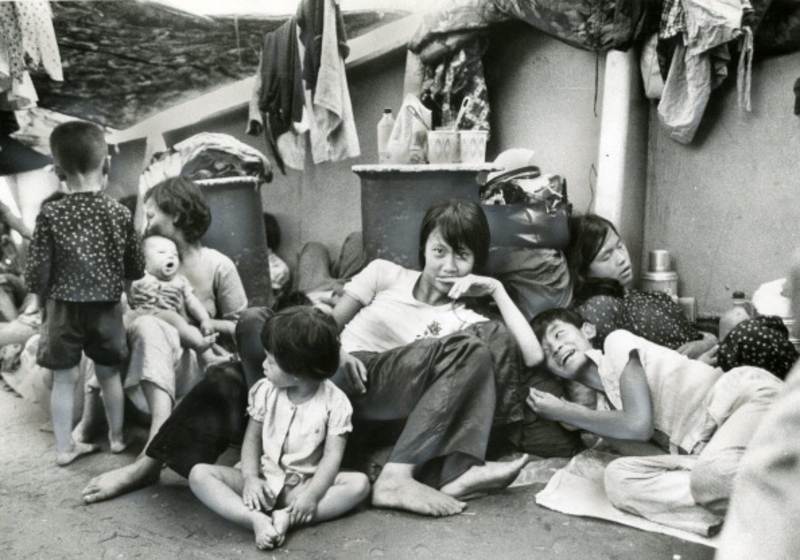
Getty Images
It is truly heartbreaking to see this rare photo of these children and their mothers who were there without a roof above their heads. The children were probably uncomfortable just lying on the ground, but they had no other choice. Unfortunately, their suffering went on for many years.
17. Camaraderie Despite the Chaos
In October 1966, a photographer named Larry Burrows captured this photo of a Marine Sergeant worried about an injured shoulder. The image depicts the terrible aftermath of tragedy. This was taken south of Vietnam’s demilitarized zone.
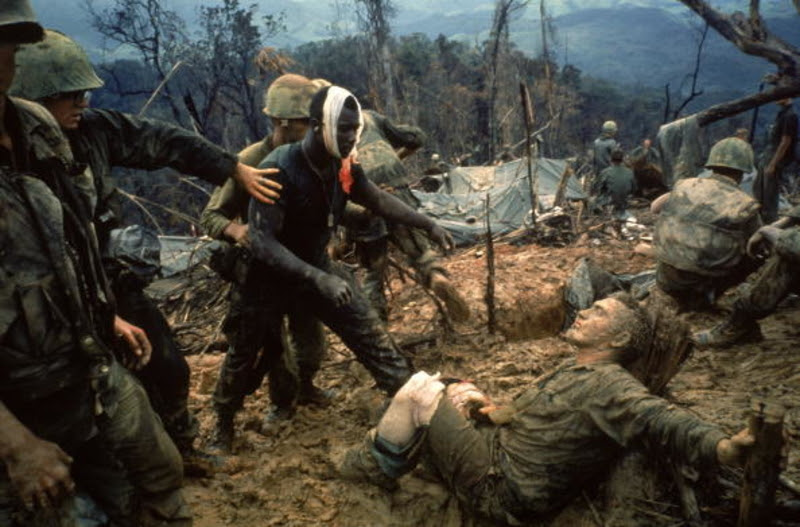
Getty Images
Despite being covered in a blood-stained bandage, sergeant Jeremiah Purdie didn’t think twice about providing assistance to his friend, who was severely injured as well. Though he was in pain, he made sure the other soldier received proper treatment.
18. A Much-needed Break
In the midst of all the mayhem and distress, nothing keeps soldiers sane aside from distracting themselves for a while. Although ironic, they had to create their own happy place just to get by and keep themselves sane.
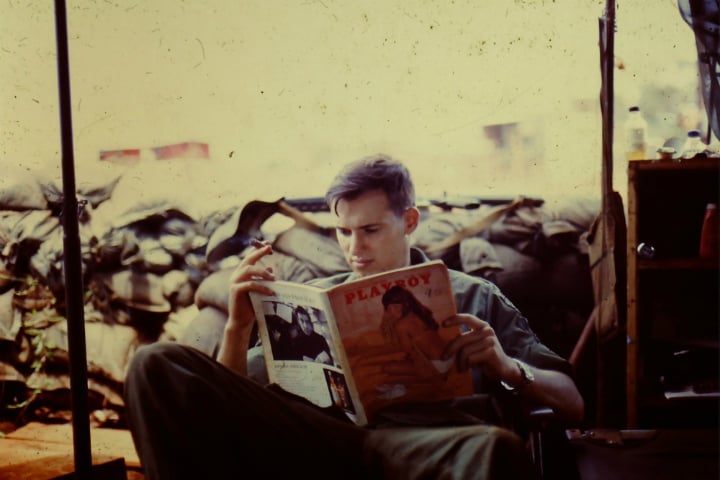
For some, reading magazines or novels brought a sense of comfort and normality, even if just for a short time. Given that the enlisted men had to leave their families and loved ones, their mental health was always at risk of plummeting.
19. Hope After Tragedy
The country was left in ruins after the Vietnam Conflict because of the widespread destruction. The conflict didn’t come to an end just because one side won; it only ended when there was no one left to fight. Vietnamese people experienced a great amount of misery when their towns were destroyed, buildings were left in ruins, communities were abandoned, and casualties surged.
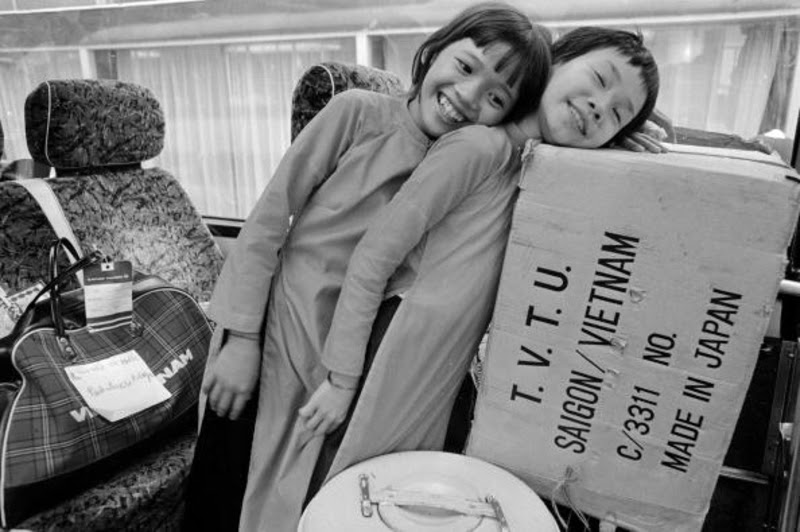
Getty Images
Look at Vietnam today, and know that those two little girls, photographed here as they smile from the back seat of a bus, contributed to rebuilding their nation after years of conflict. While some would look at this photo and see a mere snapshot, it is just as worthwhile to know that these girls were heading to a Children’s Village. There, they received the education they needed to help rebuild their society.
20. The Powerful A-1 Skyraider
Below is a photo of the A-1 Skyraider used during the Korean War by the US Military. It was the same aircraft deployed during Vietnam for the operations in the northern part of Vietnam.
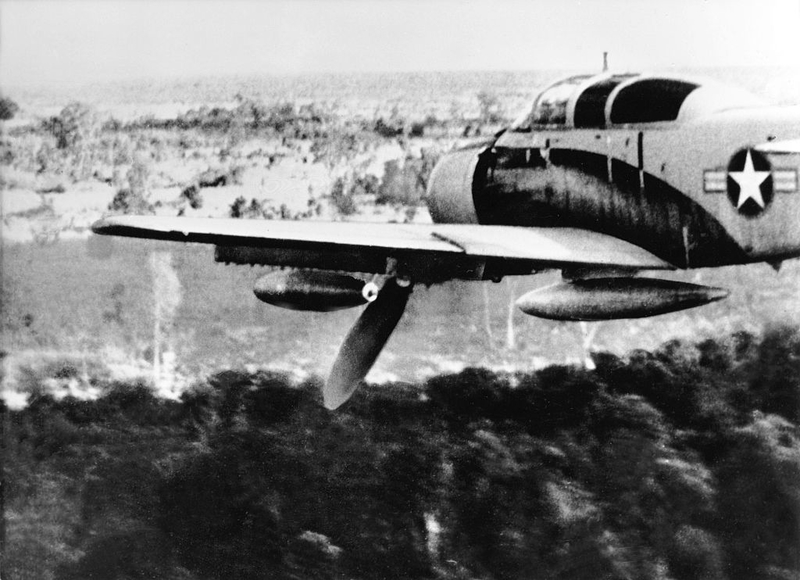
Getty Images Photo by ullstein bild/ullstein bild
In this photo, the A-1 Skyraider has just dropped two 500 lb Napalm explosives to attack the Viet Cong troops. This single-seat aircraft was equipped with missiles so powerful that it could pulverize cities in just a minute or so. The other remaining Skyraiders were lent by the US to the South Vietnamese Air Force.
21. The Hippie Movement
Everyone is probably familiar with the hippie movement that emerged in the ’60s. This movement began with peaceful protests throughout the country where people spoke about their anti-war sentiments. It was one of the most influential movements to ever rise up against the government.
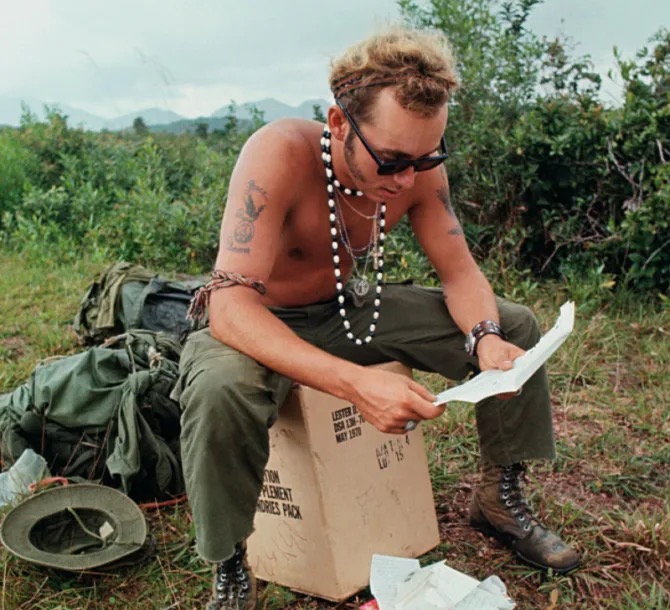
Getty Images
In the photo, you’ll notice how this particular soldier is wearing a peace pendant. With the US Army implementing mandatory military enlistment, many pacifists who were firmly against the idea of conflict were forced into the gruesome situation.
22. Danger Along the Waters of the Mekong Delta
In Vietnam, which is home to about 430 types of mammals and 800 kinds of reptiles and amphibians, danger seemed to lurk around every corner. Poisonous snakes, insects, giant elephants, and even ferocious Indochinese tigers (which are sadly now extinct in Vietnam) all were additional threats during the conflict.
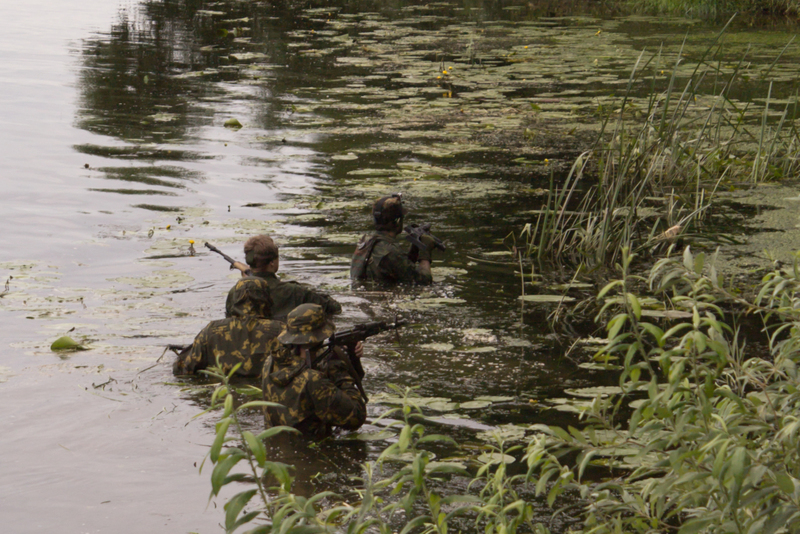
Shutterstock
The US troops had to demonstrate remarkable resilience while crossing the dark waters of the Mekong Delta. On top of the high chance of encountering dangerous animals or guerilla soldiers, maneuvers like this got their feet wet, and if they couldn’t fully dry them, they were at risk of developing trench foot (a serious and debilitating condition).
23. A Captured Viet Cong Guerilla Fighter
By 1965, the Viet Cong guerillas and the North Vietnamese Army had become influential in local villages. Because of this, they were able to quickly reload their supplies and equipment and employ more men.
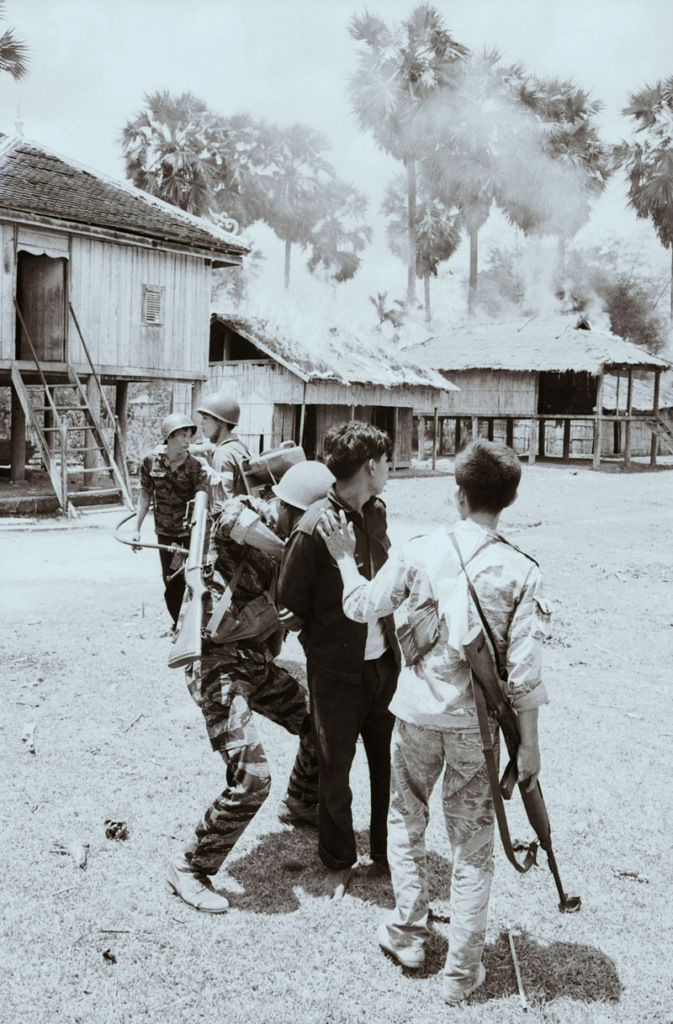
Getty Images
This gave the Viet Cong a huge advantage over the South Vietnamese Troops – an advantage that soon persuaded the United States government to increase its funding and lend more support to the anti-communist forces. The US was determined to even up the odds against their pro-communist counterparts.
24. The Weapons Kept Hidden
This image depicts a US marine and a South Vietnamese Army member searching for weapons hidden by the enemy. On March 11, 1970, the photographer captured this image at Xuan Thieu village. This was around the time when the United States attempted to reach out to North Vietnam for a peace treaty, but nothing came of it.
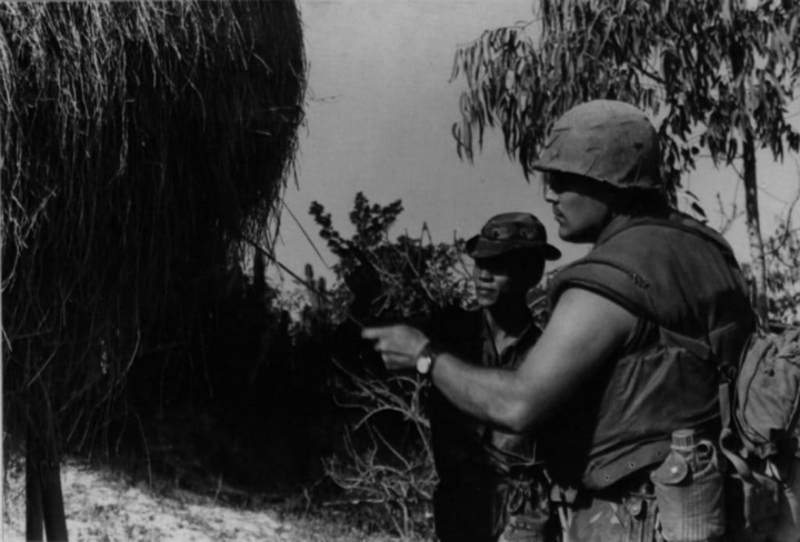
As the North Vietnamese forces made gains in Cambodia, President Nixon ordered US troops to invade. However, these reinforcements soon discovered that they were surrounded by enemy troops.
25. Red Beach Destruction
It was reported that the communist groups upgraded their ammunition and supplies in 1965. After hearing the news, the US also leveled up its military support for the South Vietnamese Army.
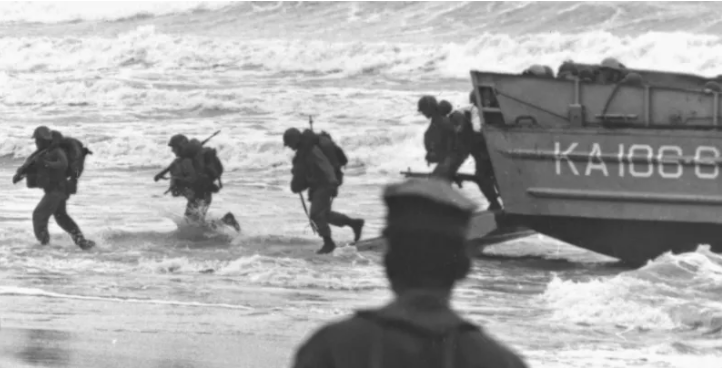
President Lyndon Johnson made a presidential decree, and the US gave approval to two marine battalions to dock in Red Beach. This topped off the increase in men, supplies, and artillery and protected the Da Nang Air Base. However, the situation quickly got out of hand. A battle broke out with Viet Cong guerilla fighters, destroying Red Beach.
26. The Plight of Women During the Havoc
Vietnamese women were well-known for their bravery and heroism throughout the Vietnam Conflict. Countless women enlisted to fight in the army (for the People’s Force of North Vietnam, the Viet Cong, or South Vietnam’s anti-communist army). Below, you can see two young women loading their gun and preparing to defend their village from the US army.
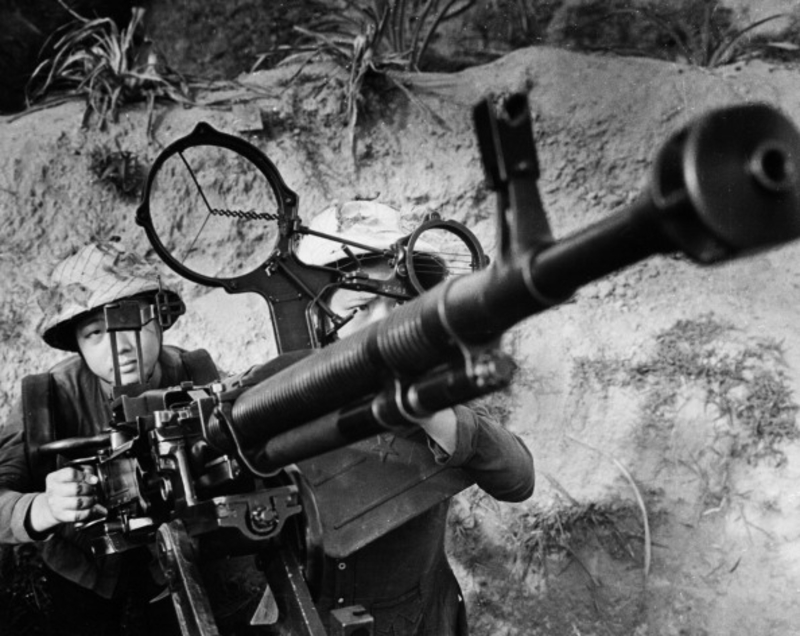
Getty Images
The two women were among a small group of villagers defending a Vietnamese village called Hoa Lok. The photo was taken in September 1967. The two women were both honored with the Feat Order of the third stage for their bravery. The Feat Order is a decoration that the Government of Vietnam gives to those who have performed exceptional feats of bravery in combat.
27. Discarded Military Uniforms
The key to winning a battle is to survive it. The image here depicts abandoned army uniforms worn by South Vietnamese Army troops to disguise their identities. When they got news of an incoming enemy attack on the outskirts of Saigon, the troops discarded a large number of boots and army gear in the middle of the road and ran for their lives.
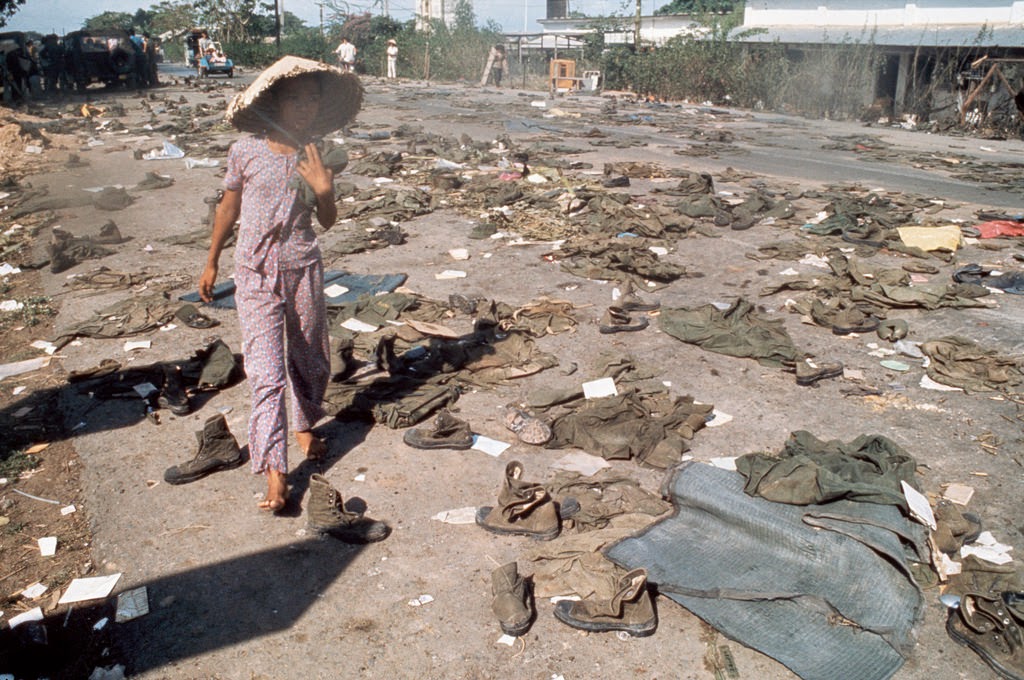
Getty Images Photo by Jacques Pavlovsky/Sygma/CORBIS
“A true winner knows when to fight their battles,” as the saying goes, and what the South Vietnamese Army Soldiers did was indeed a brilliant example of that. Who knows what would’ve happened if they’d been imprisoned by the notoriously ruthless North Vietnamese Army.
28. The Viet Cong Hideout
Below is an eerie photo showing a South Vietnamese soldier who was presumably directing his battalion to the hiding place of the Viet Cong troops. As you can see from the tombstones, this battle took place in a cemetery, which adds a poignant note of sadness to the violence.

Getty Images
Cemeteries already fill many people with a sense of foreboding, but this one had Viet Cong guerilla fighters hiding out among the tombstones. Hoping they wouldn’t lose their lives, the soldiers bravely went to the cemetery despite the eerie atmosphere.
29. The Fall of South Vietnam
Below is an image that made history. This iconic photograph of the Vietnam War shows the North Vietnamese Army driving a tank through the gates of the Presidential Palace in Saigon. This was when South Vietnamese President Dương Văn Minh surrendered to North Vietnamese Colonel Bui Tin, ending the Vietnam Conflict on April 30, 1975.
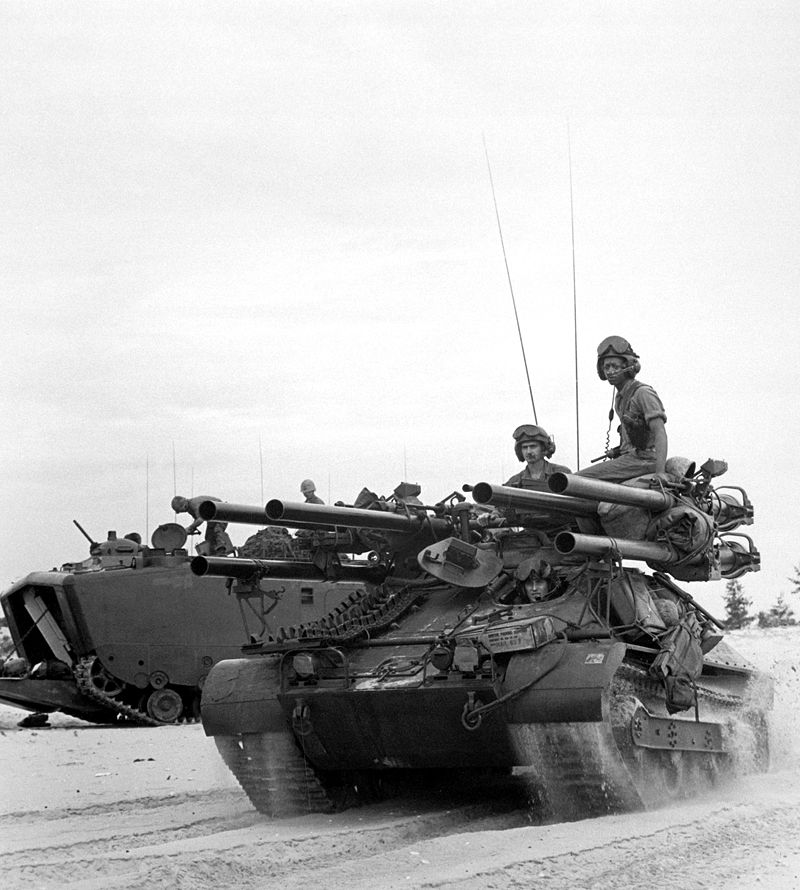
Alamy Stock Photo
The communist victory was preceded by twenty years of conflict. The North Vietnamese troops captured many cities and other facilities as they advanced closer to the South Vietnamese capital, Saigon.
30. The Military Women of Vietnam
During the Vietnam Conflict, many Vietnamese women played an important role. This image, taken on August 25th, 1965, shows a young female soldier suspected of being part of the Viet Cong army being questioned by the South Vietnamese army. You could see by the woman’s expression that she knew what was about to happen to her.
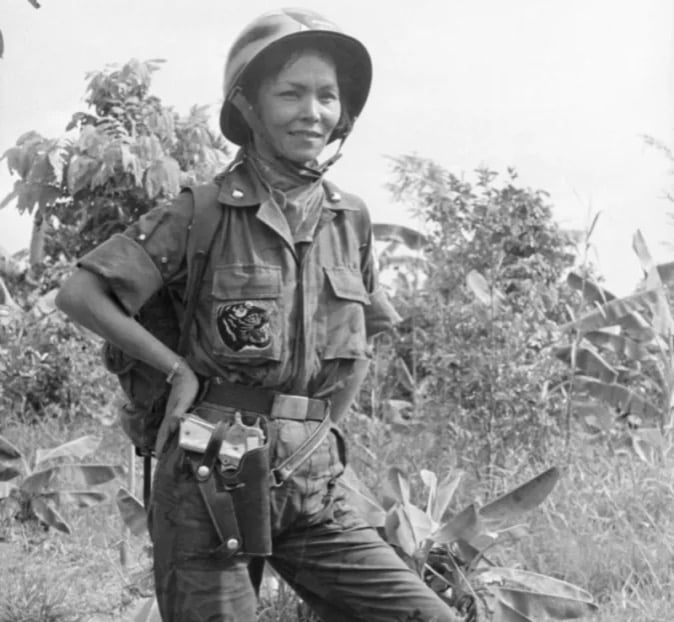
Getty Images
Women from South Vietnam served in many different capacities, from doctors and engineers to military personnel. A few thousand women had to fight in the trenches and experience the same hellish conditions men did.
31. Grab as Much as You Can
Below is an image showing South Vietnamese civilians taking as many goods as possible after raiding the Newport commissary after it was closed down. The Americans had heard of the expected evacuation that would accompany South Vietnam’s downfall and the end of the conflict.
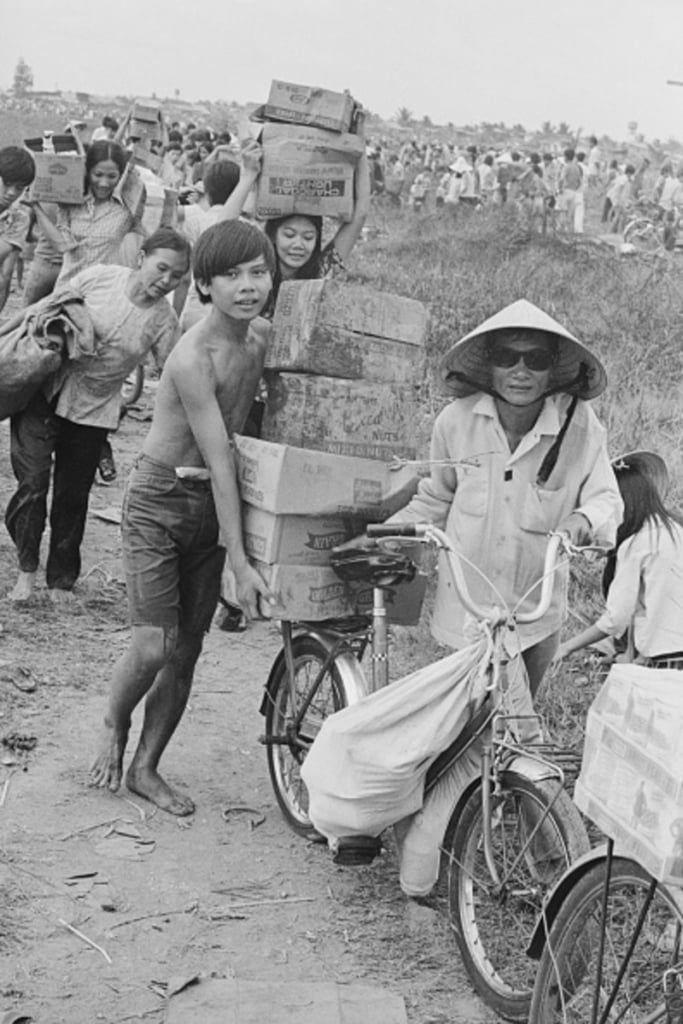
Getty Images
The first commissary built in Saigon was operated by the US military for its members. More of these stores started to be opened in the early 60s, around Saigon and elsewhere in Vietnam. They typically carried most of the top American brand names to keep the servicemen as happy as possible.
32. Preparing for Action
The Vietnam War was fought in a landscape full of hills, jungles, and rice paddies, which meant both sides had many places to hide. However, they were also vulnerable to extreme weather conditions that made it harder to move around and made the heavy equipment challenging to use.
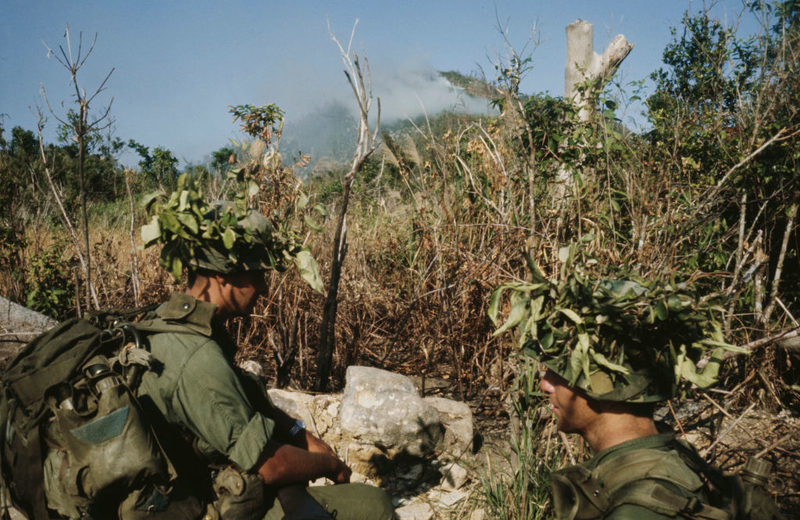
Getty Images Photo by Bettmann Archive
A rifle battalion prepares for action in a Vietnamese field in this photo. The tall grass gives soldiers a natural hiding place. Still, people could easily get lost amongst the leaves, making it difficult for fighters to spot their targets from afar.
33. The Resistance of the South Vietnamese
The United States wasn’t the only country fighting a conflict against communism in Vietnam. In fact, it joined a dispute that was already going on between North and South Vietnam. This photo shows marching soldiers from the South Vietnamese Army.
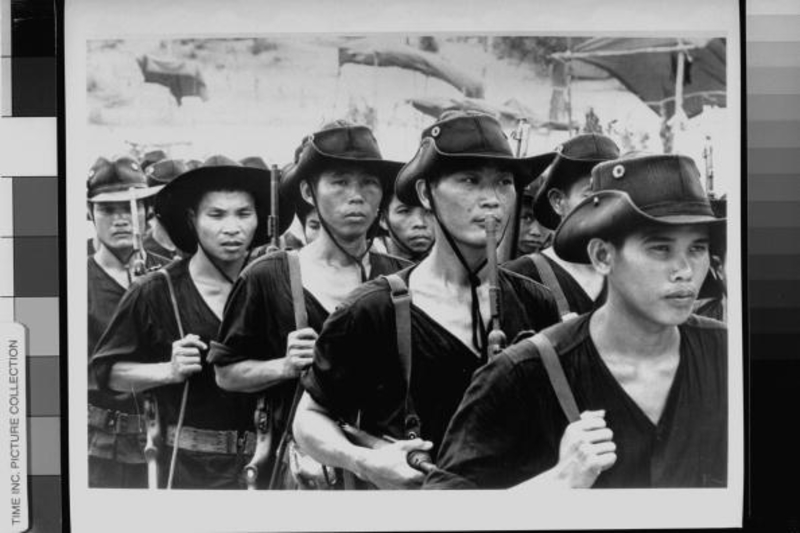
Getty Images
Though this is a typical picture of servicemen on duty, the look on these mens’ faces is terrifying. You can see a mix of courage and eagerness to fight. There’s also a sense of dread and weariness that’s particularly noticeable on the last two soldiers in the line.
34. Animals Were Dragged into the Dispute
In the past, horses were the most common way of transportation for people. However, elephants also provided great aid during the time in Vietnam. Both North and South Vietnam utilized elephants to do something that humans and machines couldn’t do. The elephants were strong enough to traverse rivers while carrying heavy ammunition and supplies.
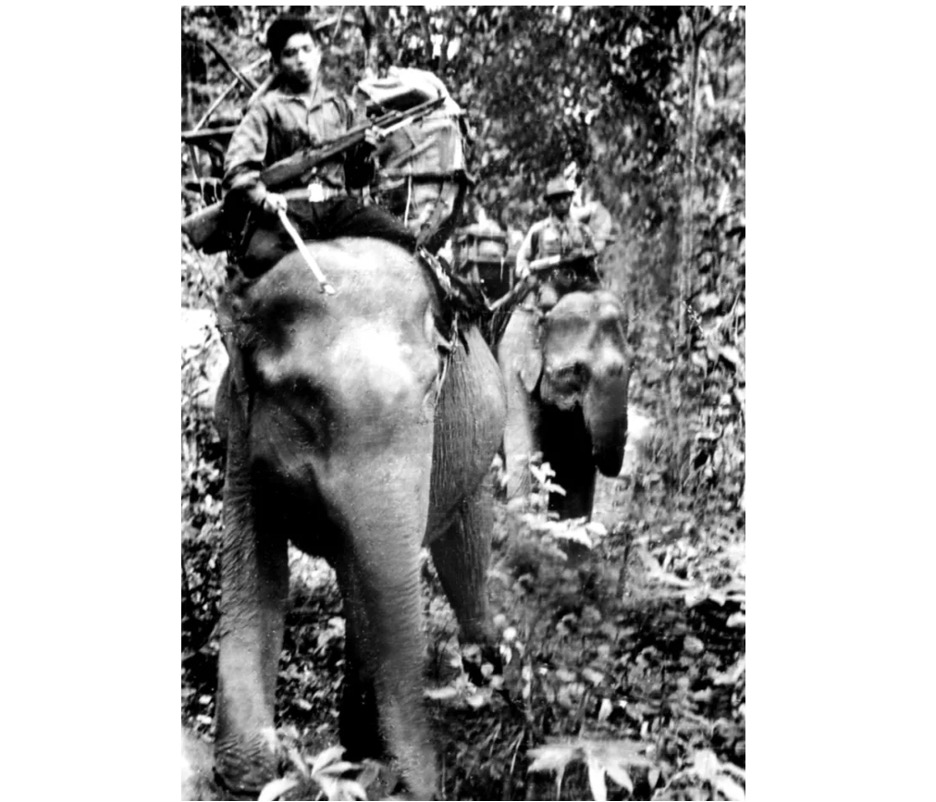
Getty Images Photo credit AFP
In fact, to help a South Vietnamese village survive, US Army Special Forces dropped two elephants during “Operation Bathroom.” The moment was so notable that it even inspired the movie Operation Dumbo Drop.
35. A Perfect Spot for Booby Traps
Vietnam is a land of dense jungles and rugged terrain, so Vietnam’s army were able to set up booby traps perfectly. These traps were easily covered in seconds. In this devastating photo, a soldier gets help from a friend after being severely injured by a phosphorous booby trap.
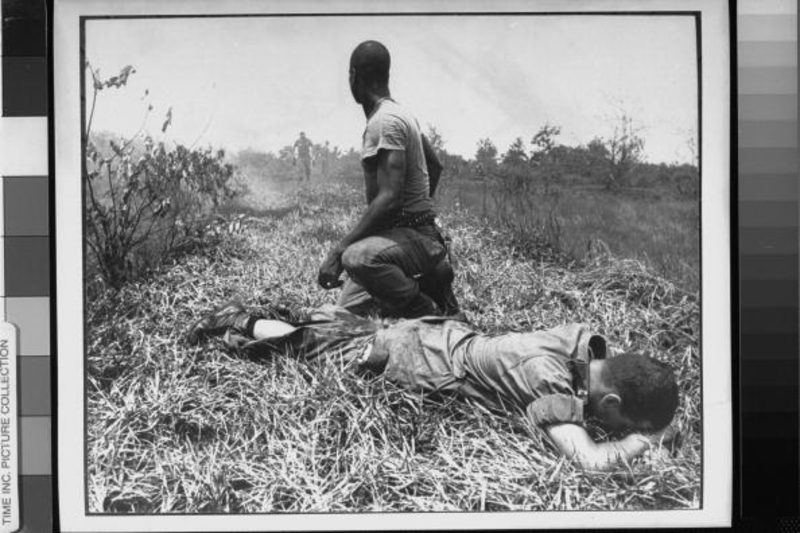
Getty Images
There are many types of booby traps, but phosphorus traps are said to be one of the worst. Phosphorus is an extremely reactive chemical that can cause terrible burns in a matter of seconds.
36. Protests Erupt
This photo shows one of the many anti-war protests that occurred in the 1960s. Anti-war sentiment was greatly intensified as people could not comprehend, let alone support, why the United States had to get involved in the first place. The movement began with a handful of peace activists and college students. It multiplied in 1965 after the United States started to incessantly bomb North Vietnam.
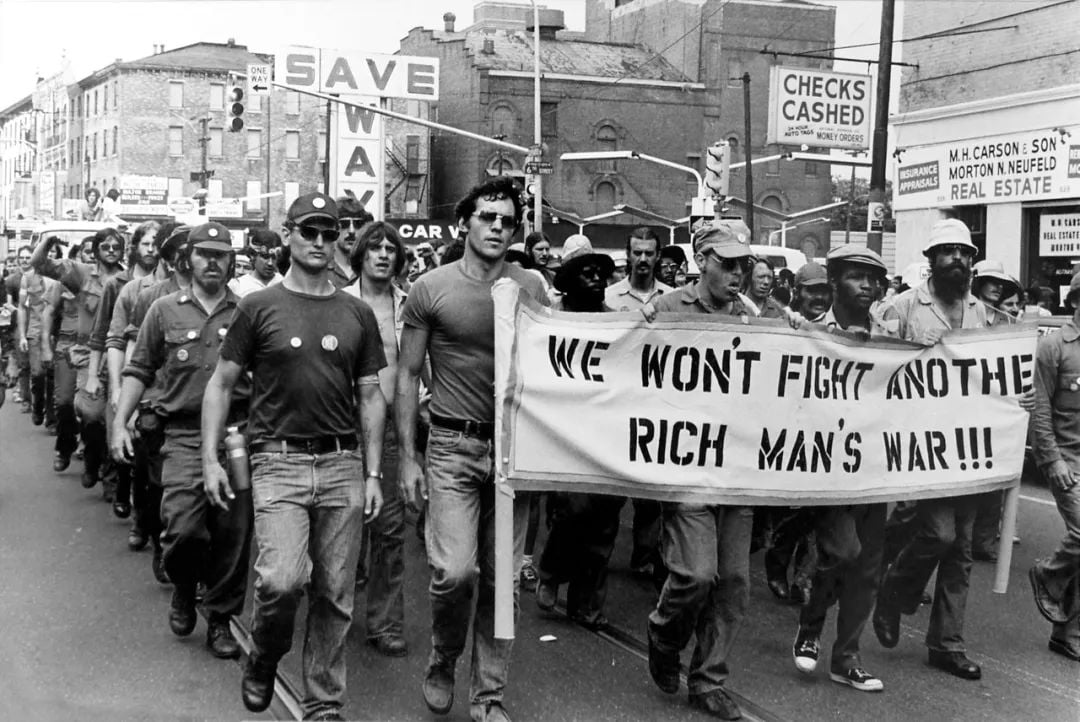
In 1965, the number of anti-war protests began to rise. It reached a peak in 1968 when the Tet Offensive by North Vietnamese forces showed to the public that the conflict just wasn’t going to stop anytime soon, and the toll had already been much too high.
37. Ordinary Men at the End of the Day
The ARVN was an army that fought for the Republic of Vietnam between 1955 and 1975. The image below shows a gathering of soldiers in April 1967. What’s really interesting about this image is that, even though they had to face massive atrocities every day during the battle, they still found time to enjoy themselves at the end of the day.
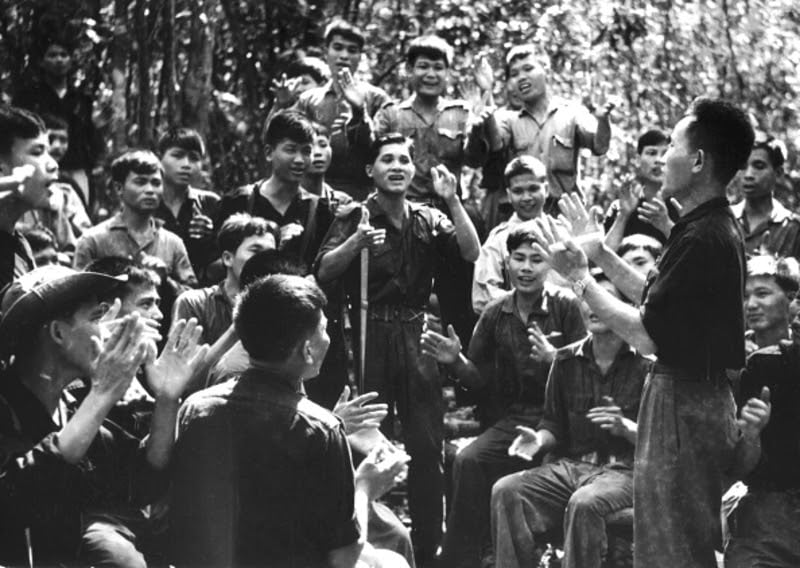
Getty Images
Though they were most likely discussing an offensive approach or strategy in general, several of these men appear to be rather joyful and pleased. Unfortunately, it is believed that the ARVN lost around 1,394,000 men during the conflict.
38. The Beautiful Racquel Welch and Bob Hope
Racquel Welch, along with Bob Hope, traveled to Vietnam to entertain troops fighting in Vietnam. Government-sponsored shows like these helped the servicemen deal with the harsh conditions of the conflict.
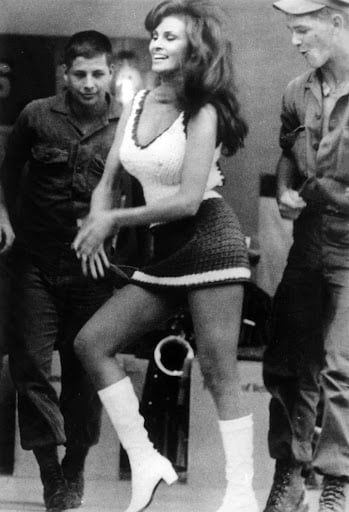
Getty Images
While the men who served were away from their families, the two made sure to keep their spirits up with dances and parties. Here, Racquel Welch can be seen vibrantly dancing while just out of frame, legendary performer Bob Hope sings on stage. Clearly, these men are in awe of Ms. Welch. They can’t help but stare in admiration as she entertains them with her dance moves.
39. Ships for the Refugees
The population of Vietnam rapidly decreased after the end of the 20-year Vietnam Conflict. The majority of people were forced out of their homes and became refugees. A picture was taken inside a ship filled with refugees at the central Vietnamese city Da Nang Harbor in 1975.
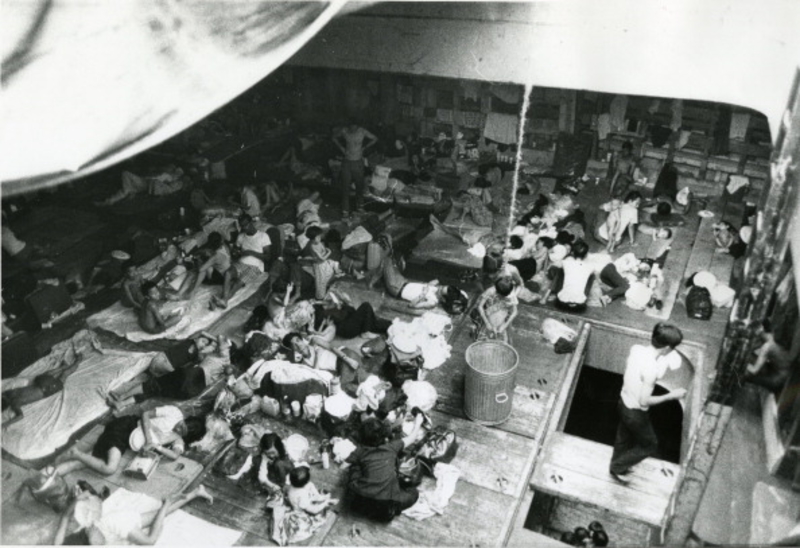
Getty Images
Most South Vietnamese refugees fled to the United States hoping for a better life, avoiding government oppression in their own country. The photo shows that Vietnamese refugees endured inhumane conditions as they were forced to evacuate their homes and undergo a grueling voyage to a foreign land.
40. Escaping Saigon
The number of Vietnamese refugees was astounding, and it just kept growing, reaching over 1.6 million after the fall of Saigon in 1975. The photo below depicts a desperate refugee helping another refugee board a barge as they try to escape Saigon.
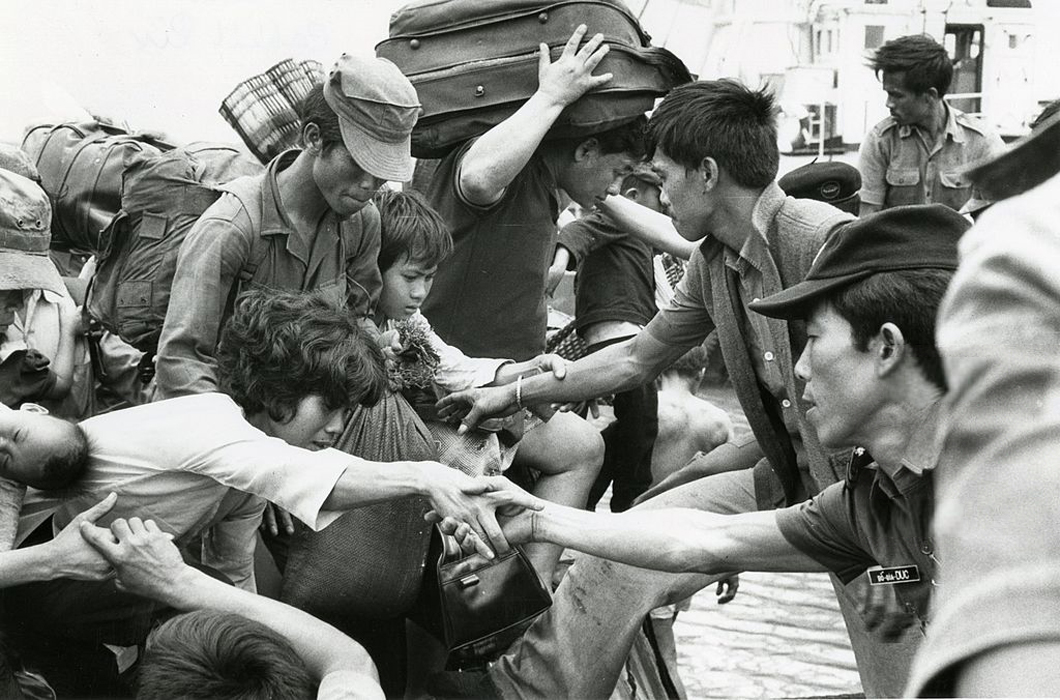
Getty Images
This was a painful truth that the people of Vietnam had to face after suffering from the 20-year Vietnam Conflict. The haggard, worn-out looks of the women, children, and men are evident in this photograph. Nobody escaped unscathed.
41. Face-to-Face Encounter
Perhaps one of the most incredible images from the controversial Vietnam War is the image below. Fighting a conflict presented many complex problems to deal with and this photo is an illustration of a close combat between the well camouflaged South Vietnamese Army and the Viet Cong soldiers in the muddy rice fields of the Mekong Delta region.
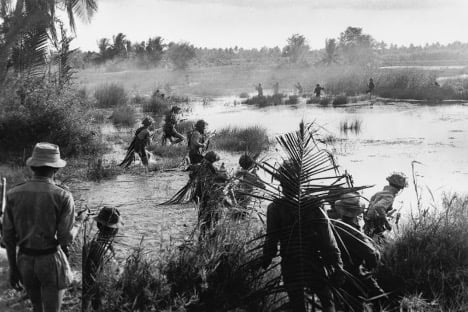
Thanks to the thick vegetation of the Mekong Delta, the anti-communist group was able to pursue their unrecognized movements against their enemies.
42. Much-needed Distraction
To give respite to the battle-torn troops, the government would invite U.S military members to shows by local performers. The live entertainment was meant to aid fighters and help them cope with the passing of their allies and numerous monstrosities of conflict.
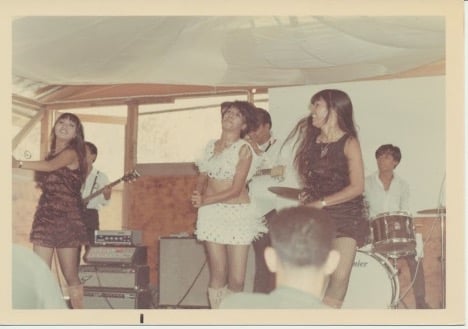
Getty Images Photo by Stuart Lutz
As the U.S troopers bonded with Vietnamese people during these events, many of them formed romantic relationships with Vietnamese women. Sadly, as some kicked the bucket in the conflict, and the American government sent the others back to their nation, these American/Vietnamese kids never got the opportunity to meet their dads.
43. Creepy Guardian
Take a look at this eerie picture showing a human skull overseeing a camp of US servicemen in the wilderness of Vietnam. This particular fighter looks unfazed as though he has become used to the horrors around him, including not being disturbed and worried by having a human skull so close to him.

Getty Images
There are some soldiers who believed that a human skull acted as a quiet watchman to look after their troop, instigating fear on enemies that attempted to come near them.
44. A Mother Begs for Mercy
One of the most heartbreaking images on this rundown, the picture underneath shows a Vietnamese lady by the name of Cong-Hoa pleading with a US serviceman to save her son, who was captured subsequent to being confused with a Viet Cong assailant.
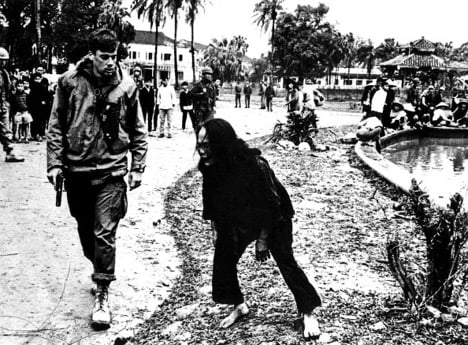
Getty Images
There were many instances of wrongly captured civilians that were speculated to have a place with the cruel Viet Cong armed force. This woman looks devastated with the atrocities around her. Worse, she additionally needed to beg for her son’s life.
45. Running for Safety
This picture taken in the ‘60s catches a group of South Vietnamese fighters under enemy fire, as they run for their lives. Once more, we see the tremendous nature that surrounded these troops and learn how simple it was for their enemies to initiate a surprise assault.
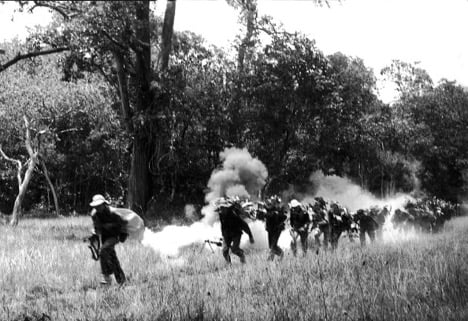
Getty Images
Between the dense forest trees to cover in and the booby traps on the ground, these fighters never foresee an attack approaching. To ensure their safety, they had no other choice but to run as fast as they could.
46. An Empty World
Probably one of the most gut-wrenching images from Vietnam is the photo shown below. An older lady sitting in a heap of rubble, in her town of Phuc Loc. She is devastated and frantically sobbing after her whole town was attacked by Americans on April 16, 1972.
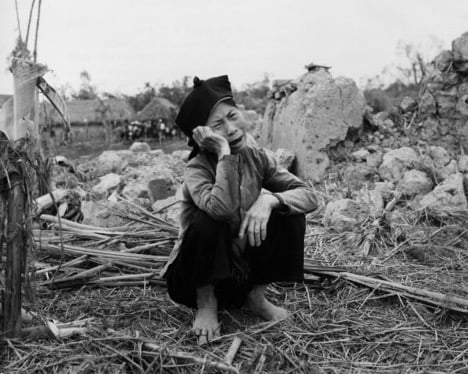
Getty Images
This photo is an illustration of the havoc and destruction that the conflict left behind in its wake. What was once cherished as a home for this woman’s family and their neighbors was destroyed in the matter of minutes.
47. Break Time on Base
The members of the 11th Armored Cavalry were headquartered at the Blackhorse Base Camp and led a few extremely perilous operations in North Vietnam. This photo shows how the US soldiers spent their downtime- playing their guitars at a plantation in Loc Ninh and Quan Loi.
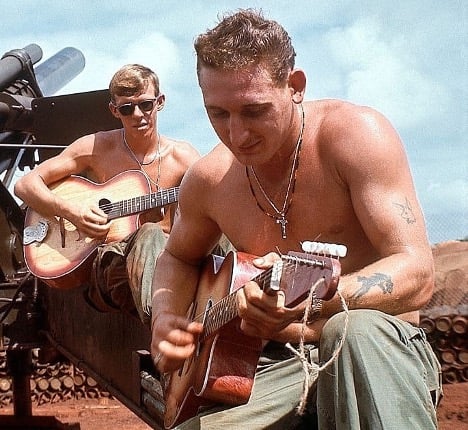
Bettmann/Getty Images
In the US, the Vietnam War Moratorium Committee had formed a public work shutdown and huge protests. Millions of people held rallies throughout the United States to encourage a quick stop to the bloody conflict.
48. The President’s Message to South Vietnam
This image shows a group of soldiers gathered around a radio, drinking coffee and paying attention to the president’s Nov. 3, 1969 speech. To South Vietnamese individuals, the president expressed that they would have the continued support of the US troops.
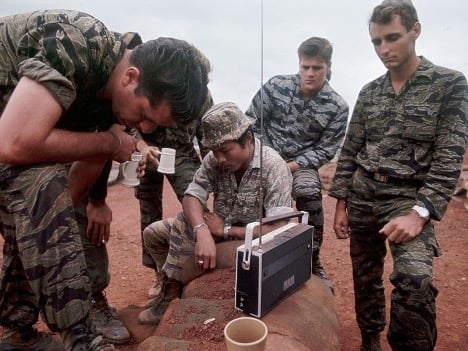
Bettmann/Getty Images
Accordingly, the presence of the US military would deliberately decrease as more South Vietnamese troops were prepared to fight for themselves. The speech also requested support from American people who did not participate in the counterculture and anti-war movements.
49. Christmas Tradition
A truce was proclaimed on Christmas day for every year of American association in the controversial Vietnam Conflict. And while there were a lot of motivations to surrender, military members put forth a valiant effort to make themselves happy during Christmas time.
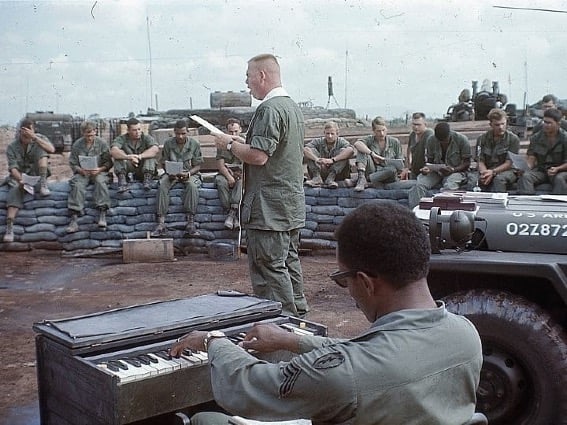
Bettmann/Getty Images
As seen in the above photo, members of the 25th Infantry Division were actively participating in Christmas functions at Củ Chi Base, northwest of Saigon. Portions of the camp sat on top of the Củ Chi tunnels that the enemy used to intensify attacks and move supplies.
50. Christmas Day in POW Camps
As a glaring contradiction to the previous image, U.S. Navy Lieutenant Commander Richard Allen Stratton celebrated Christmas Day in 1965 taking care of a garden in a POW camp in North Vietnam. Stratton had to discharge after he launched a rocket that failed and quashed his own airplane behind enemy lines, hence his imprisonment.
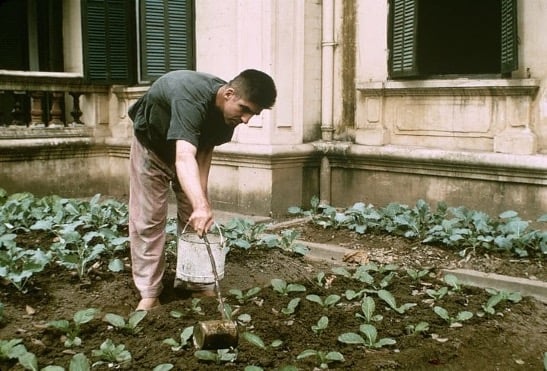
Bettmann/Getty Images
His controversial picture bowing profoundly in jail uniform was the consequence of persecution. He wished his experience would expose the abuse of POWs in North Vietnam. Following over six years of detainment, he was released, gaining recognition for his governance and valiance.
51. The Arrest of Buffalo Nine
Nine protesters known as the Buffalo Nine were arrested on Aug. 19, 1968 after military police stormed the Unitarian Universalist Church in Buffalo, New York. The group was indicted with attacking an officer and draft evasion. Their trial earned national attention as the University of Buffalo held massive demonstrations and rallies.
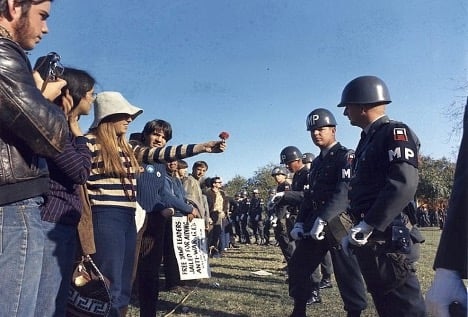
National Archives and Records Administration/Wikimedia
Three of them were convicted and sentenced to three years in jail. Violent protests exploded when the verdicts were presented. In the picture, a man holds a sign in backing of the Youth Against War and Fascism (YAWF) organization, in which Buffalo Nine member Jerry Gross serves as chairman.
52. More Civil Disobedience Against the Vietnam Conflict
To show their condemnation of the ongoing conflict, different groups of protesters held various schemes such as staged walkouts, the burning of draft cards, campus rallies, and much more. Back on May 1, 1971, many demonstrators immersed themselves in conducts of civil disobedience throughout Washington D.C.
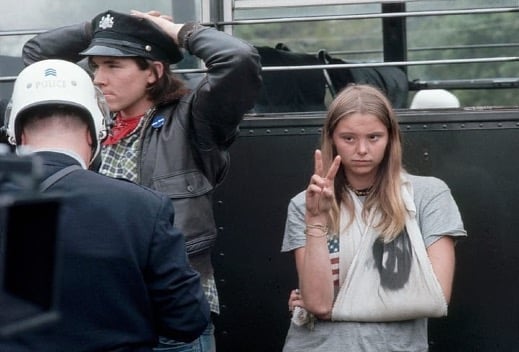
Photo by © Wally McNamee/CORBIS/Corbis via Getty Images
The photo above shows two protesters arrested for their acts. Not one with remorse, a young lady shows off the peace sign while being walled against a bus that will bring them to booking.
53. Bravery of The Wounded
On March 9, 1967, Army Specialist 6 Lawrence Joel became the very first medical corpsman to earn the Medal of Honor in the Vietnam War. He was shot in the leg and immediately treated his own wound and bravely helped his fellow injured soldiers.
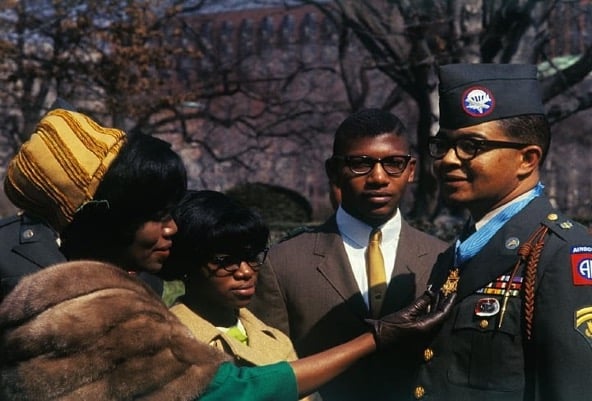
Bettmann/Getty Images
Despite his condition at the time, he would yell words of comfort to other troops as he treated the injured. It was more than 24 hours before the conflict finally concluded and he and the rest of the men could be safely moved out.
54. Suspected North Vietnamese Prisoners
Operation Cedar Falls, the biggest ground operation of the conflict, aims to annihilate the Iron Triangle, the high-profile Vietcong fortification northwest of Saigon. Numerous North Vietnamese soldiers escaped the assault or stowed away inside the complicated underground tunnels. Even if Operation Cedar Falls denoted a triumph for the South Vietnamese, it didn’t prevail in constantly devastating the fortification.
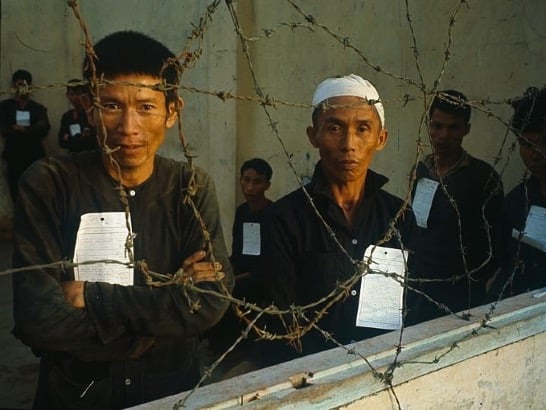
Bettmann/Getty Images
Above, suspected Viet Cong fighters are detained in a somewhat annihilated structure in Saigon soon after the mission. The paper stuck to their shirts is to check them for later cross examination.
55. Swift Boats Along The Saigon River
Patrol boats were commonly engaged with firefights on the Saigon River. Generally, the battle arose during endeavors to upset the transportation of North Vietnamese weapons.
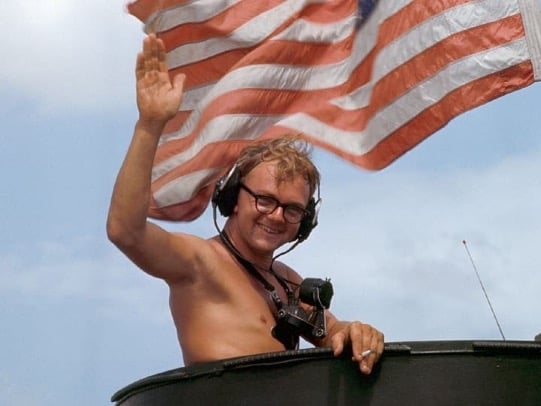
Photo by © Tim Page/CORBIS/Corbis via Getty Images
Patrol boats likewise carried infantry and gear to and from battle, giving a large part of the transportation into the most profound scopes of the Project DELTA, which included strategic operations past enemy lines. After the conflict patrol boats were pulled out by the US Navy. Seen above, a gunner manning a Monitor Swift boat flashes his big smile.
56. Yoko Ono and John Lennon
Musicians and peace activists Yoko Ono and John Lennon are seen in this photo for a campaign they launched in 1969 for a benefit concert in London for UNICEF. Yoko flashes a sign that reads “War is Over!,” and Lennon displays a “bag of laughter” — a voice recorder that plays laughter.
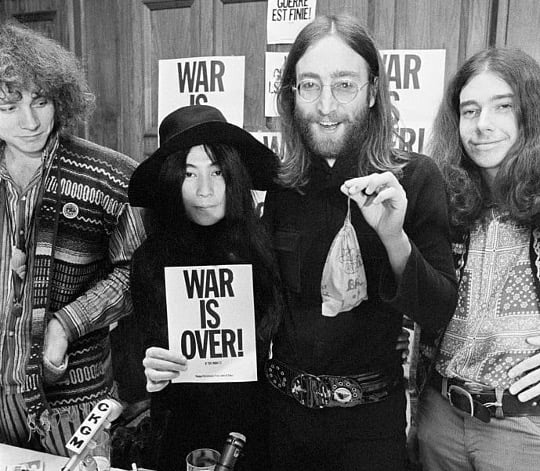
Bettmann/Getty Images
The pair is attending the Vietnam War peace conference in Montreal. After a year, they would hold their popular “Bed-In for Peace,” where they welcomed people to watch them in pajamas, enclosed in flowers and encouraging messages of peace.
57. North Vietnamese Publicity
In North Vietnam, handouts and unauthorized writings on public walls castigating American contributions in the conflict were a normal view. Because of the shortage of materials accessible to the Viet Cong, publicity was frequently imprinted on anything they could find.
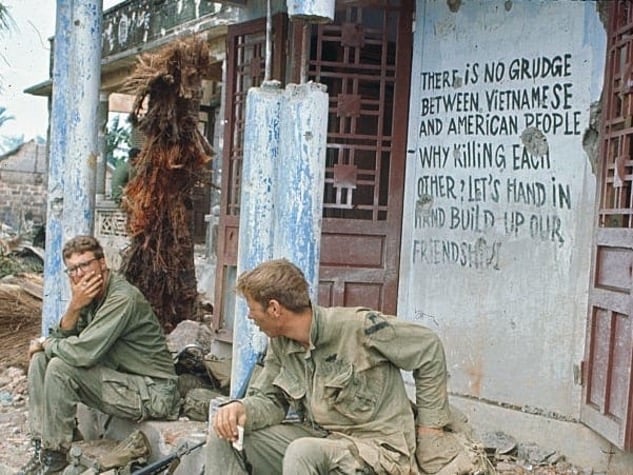
Bettmann/Getty Images
The National Liberation Front often disseminated illustrations of commmunist iconography and Viet Cong triumphs. The photo above shows two men of the 1st Cavalry Division unwinding in front of publicity scribbled on an annihilated structure on March 13, 1968. The town used to be a Viet Cong supply base.
58. Intense Backlash on Jane Fonda
This photograph of Jane Fonda having a meeting with North Vietnamese servicemen at a POW camp earned the ire of numerous Americans. There was even a campaign for “Hanoi Jane” to be indicted for conspiracy. It was later revealed that Fonda had been a subject of America’s surveillance endeavors from 1967 to 1973.
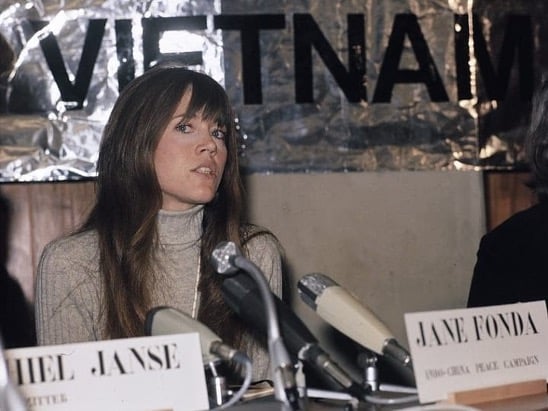
Rob Mieremet / Anefo/Wikimedia
The controversy did not sit well with Fonda, and she lamented that the photo at issue had been blown out of proportion. She had additionally met with American POWs that she said shared encouragement for the anti-war demonstration back in the United States.
59. The Tent Life
For some soldiers, life in tents meant inaccessibility to many of the amenities afforded to other troops. In this photo, a soldier makes use of a repurposed bathroom mirror and a helmet serving as a water container to shave.

Photo by Kirn Vintage Stock/Corbis via Getty Images
While troops on the front line and support soldiers battled on the same side, their day to day routines were quite different from each other. At times, those ingrained in conflict spent months without washing and were envious of the convenience and security their allies in the rear bases enjoyed.
60. Tunnel Rats
This photo shows Sergeant Ronald A. Payne, Squad Leader of 25th Infantry Division, moving through a tunnel in hunt of Viet Cong and their machinery during Operation “Cedar Falls.” The Việt Minh started burrowing a series of little, confined tunnels under the wilderness of South Vietnam at the onset of the First Indochina War (1946) to advance their guerrilla battle against the French.
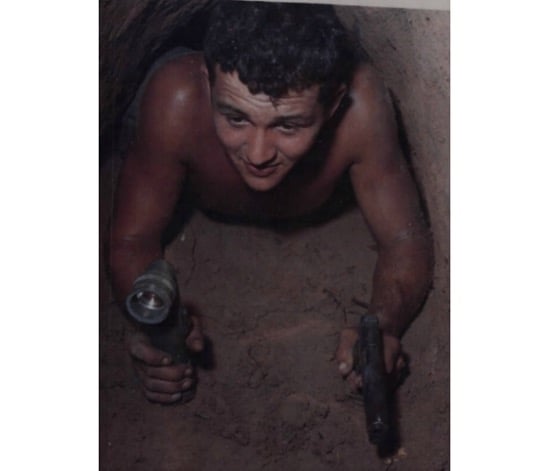
These tunnels were utilized to secretly move soldiers and supplies and set booby traps. During the 1960s, the Vietcong significantly extended the network of tunnels, connecting Vietcong bases from around Saigon to the Cambodian border.
61. An Important Message
A young soldier expresses himself with his gear. While this young man seems to have a lot of soft expression in his eyes, the message he was trying to convey speaks volumes of how many enlisted men must have felt fighting in Vietnam.
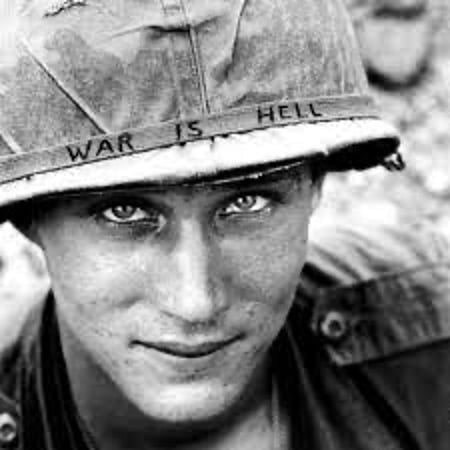
Not to mention that this statement is an understatement on the toll and generational trauma that stems from conflict.
62. A POW is Reunited
Prisoner of war, Lt. Col Robert L. Strim is photographed reuniting with his family at Travis Air Force Base in Fairfield, California.
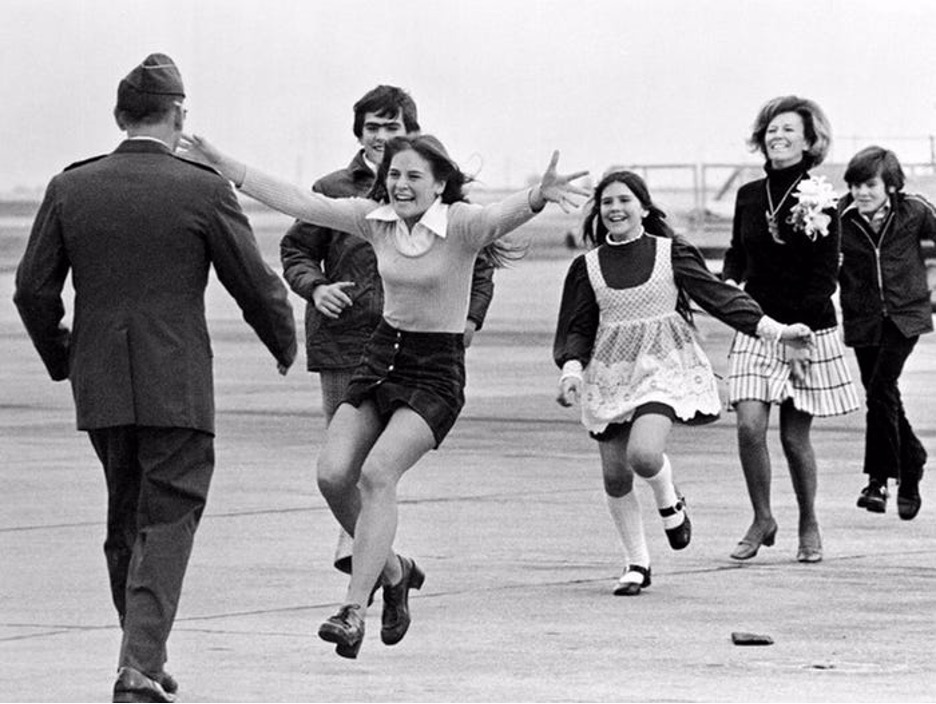
The photo, which was taken in 1973, shows him being greeted by his two daughters, two sons, and wife. The joy in all of their faces says it all.
63. Little Tiger
This photograph is especially disturbing and sad. Childhood is a fleeting time that can never be recovered and the sight of a kid in an army uniform is gut wrenching.
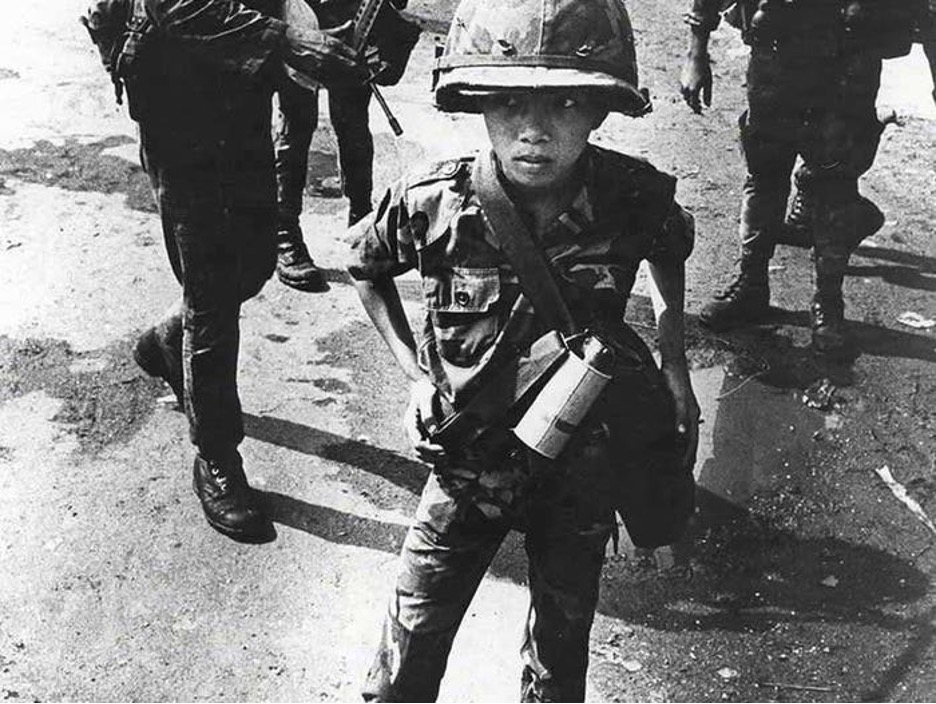
Source: businessinsider.com
This young child nicknamed “Little Tiger” was photographed by Philip Jones Griffiths. He reportedly took the lives of two Vet Cong women, and this is how he earned his nickname.
64. Forging Ahead
As most of the conflict was fought in the jungle, this photo illustrates US Army helicopters firing into trees as they attempt to rid the forest of any North Vietnamese servicemen.
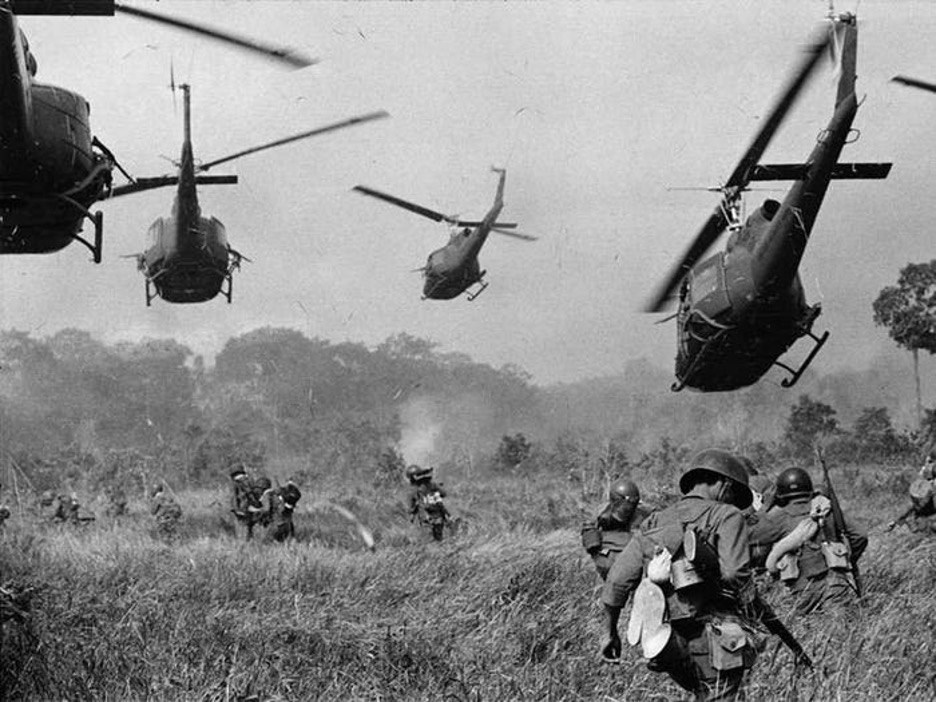
South Vietnamese soldiers follow behind on the ground as they attack a Viet Cong campsite near the Cambodian border.
65. A Difficult Terrain
Troops had to move through the thick foliage and murky waters while carrying heavy weapons and staying constantly vigilant. Not being able to see far ahead, side to side, or behind you would add an intense element of fear to an already extremely scary situation.
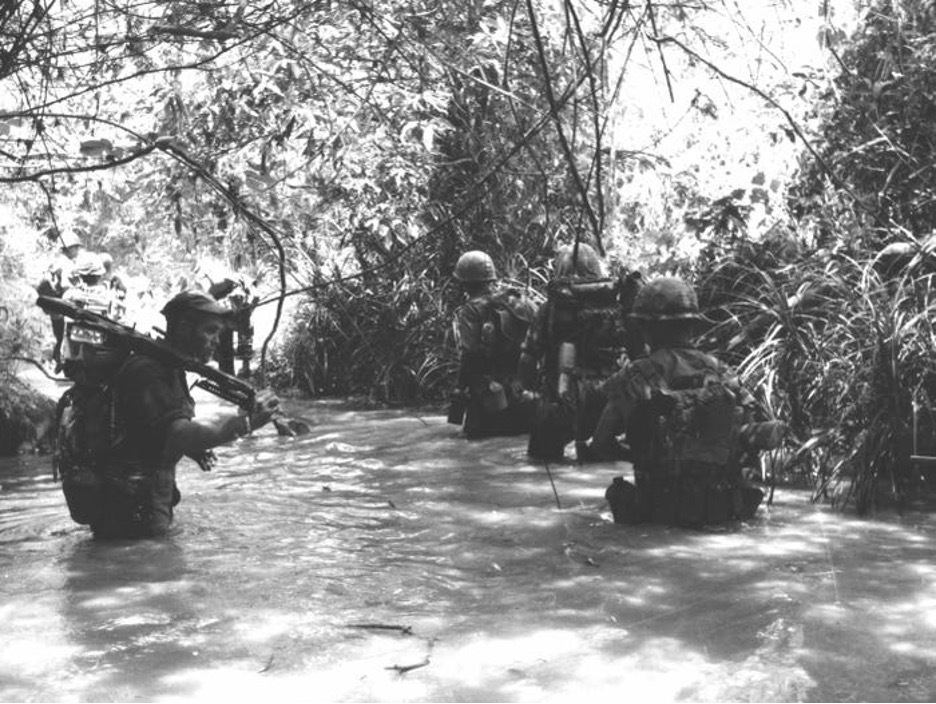
Fighting in a conflict is already tough to imagine, adding onto this an unknown jungle, it is easy to empathize with people who had to go through this.
66. Ho Chi Minh Trail
The infamous Ho Chi Minh trail was a Viet Cong smuggling route that covered the length of Vietnam. It was infamous due to the access that it gave the North to transport weapons to communist guerillas.

Pictured are South Vietnamese volunteers who are helping to carry ammunition. This photo was in 1972.
67. Ground Assault
The greatest ground assault in the Vietnam-American Conflict was on February 23rd, 1967. In this photo, the photographer captured the moment that US paratroopers launched themselves out of a moving plane.
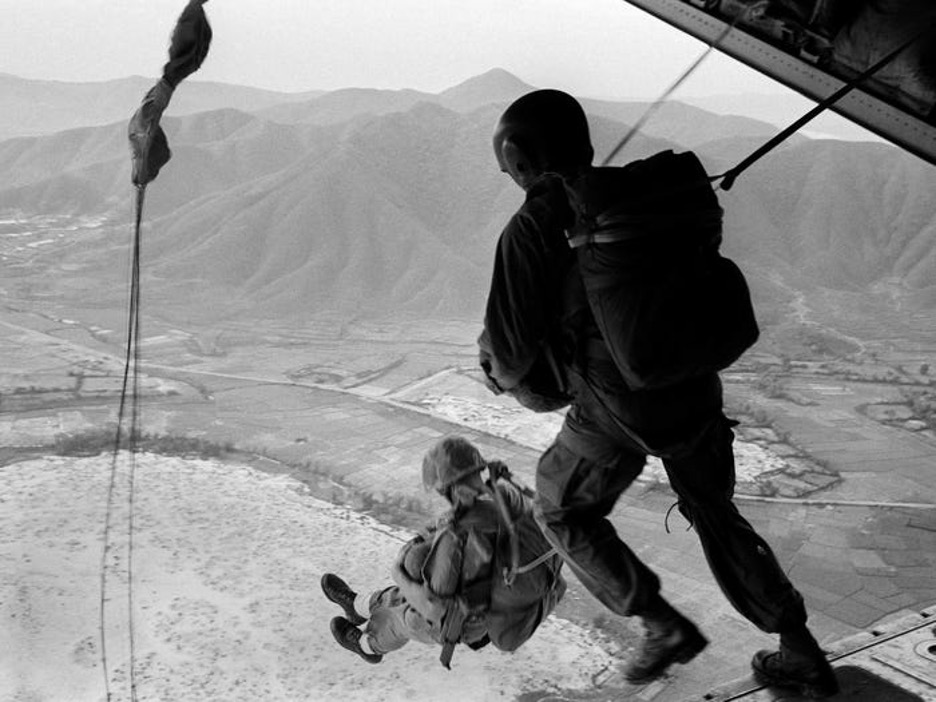
You can see that they have parachutes attached to themselves which will help them land, but there is no denying the fear of launching yourself into an attack from the sky.
68. Taking a Break
Often times, as soldiers trekked the perilous regions to fight in the brutal conflict, they would stop for snacks and smokes.

It is moments like these that highlight the humanity against the inhumanity of war, the creature comforts that soldiers took along the way.
69. LBJ Visits
President Lyndon B. Johnson visits with troops. When he took office, he inherited a deteriorating situation in South Vietnam.
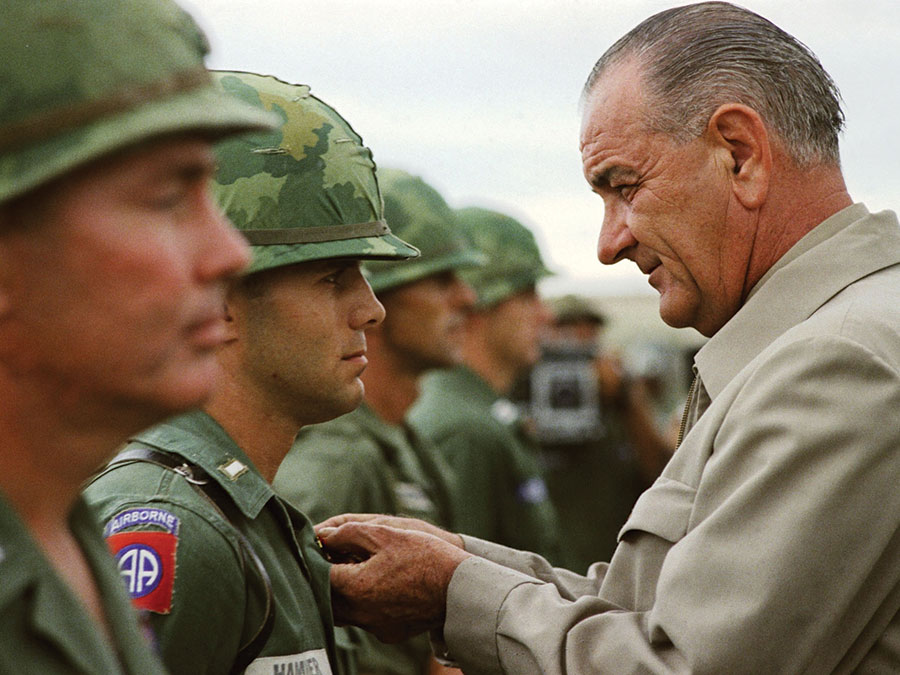
Source: NY Times
Over time, he chose to escalate the Vietnam efforts, and sent more than 500,000 U.S. troops to Vietnam.
70. The Cost of Freedom, and For Who?
Vietnam was the first American conflict where Black and White soldiers were not officially separated. About 11% of all American military personnel in Vietnam were African Americans.
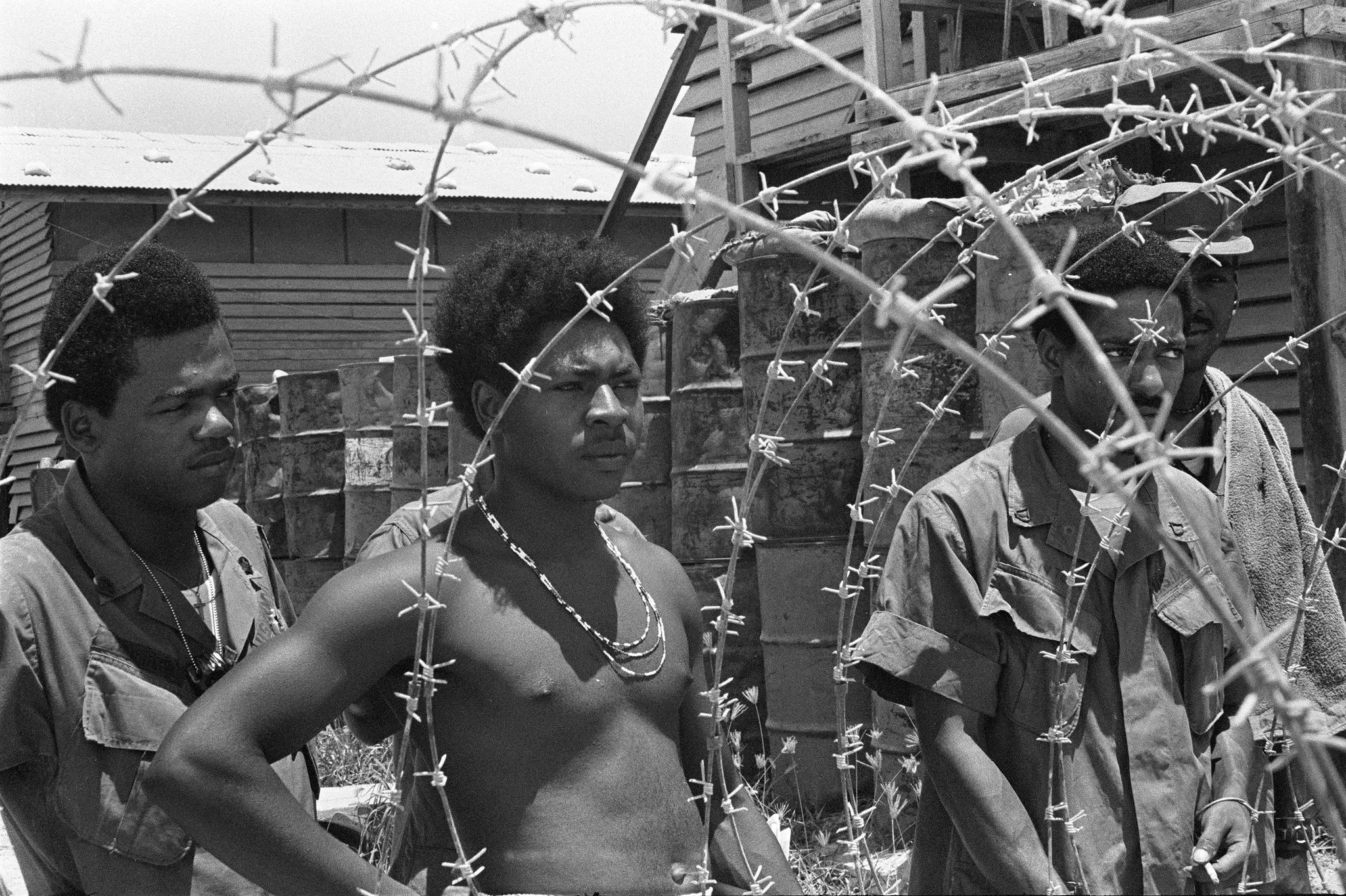
Source: NY Times
However, in this rare photo of Camp McDermott we see a group of Black soldiers standing behind barbed-wire which served to separate their living quarters.
71. A Suspected Viet Cong Member
A group of South Vietnamese soldiers and an American stand with two suspected Viet Cong fighters. This photo was taken in Plaines des Joncs, South Vietnam.
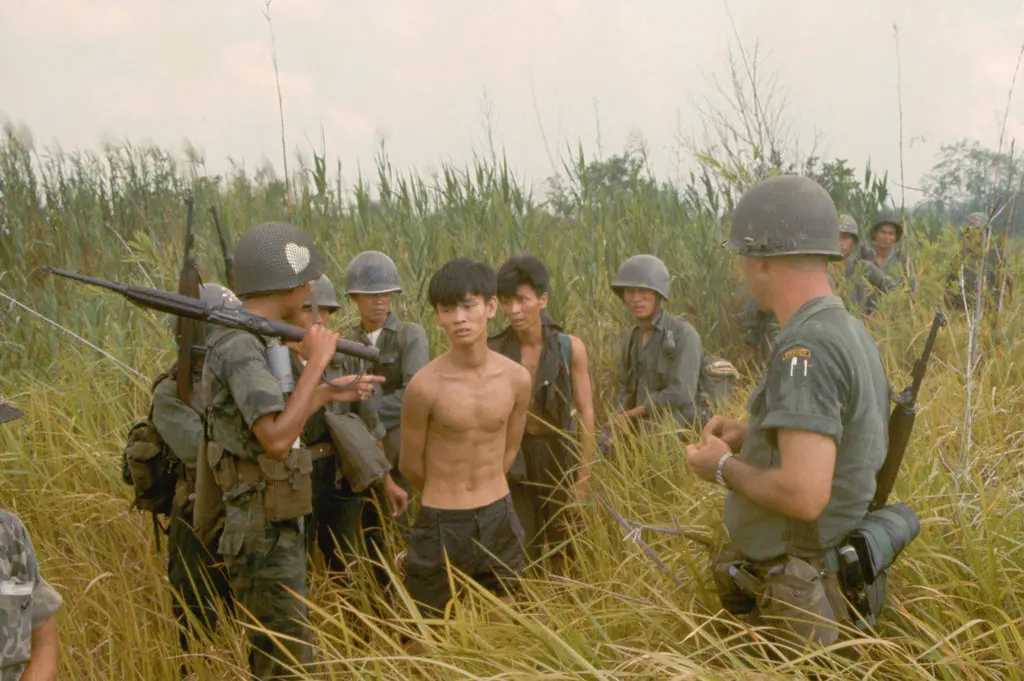
It is difficult to imagine being in any of these young men’s shoes within the context of the Vietnam conflict.
72. A General and His Troops
On the left, General Paul D. Harkins during an inspection of the troops he was commanding. You can see the etches of conflict across his time-worn face.
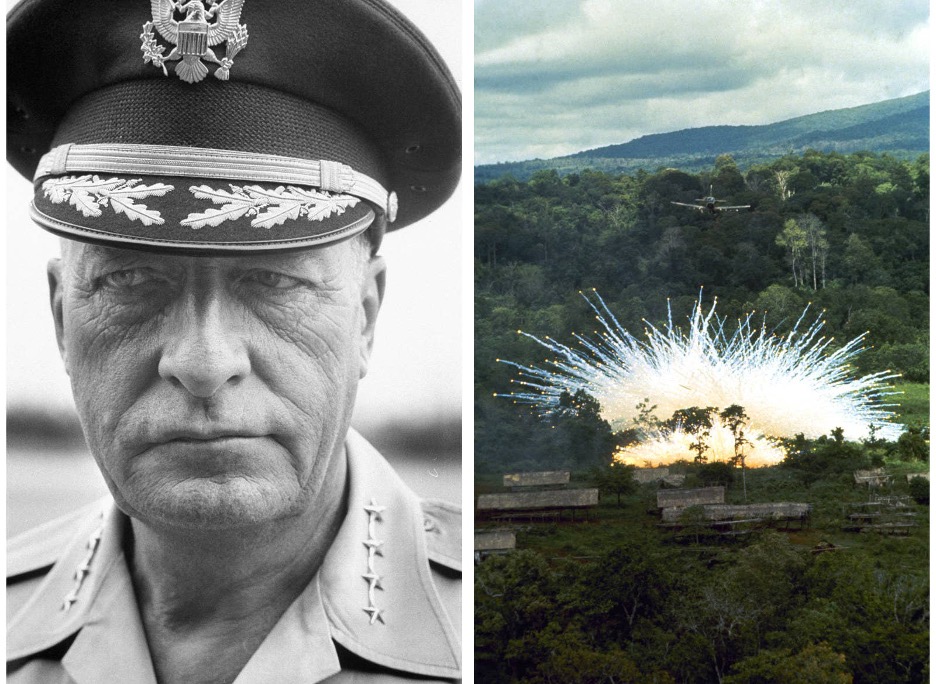
On the right, an aerial shot of a napalm shell being dropped onto a small village by a US jet. It is difficult to see the levels of destruction that was brought on by the Vietnam conflict.
73. Exhausted and Dehydrated
This picture illustrates the level of complete exhaustion that the soldiers involved in the Vietnam conflict had to endure. The man lays on the ground and desperately tries to hydrate himself.
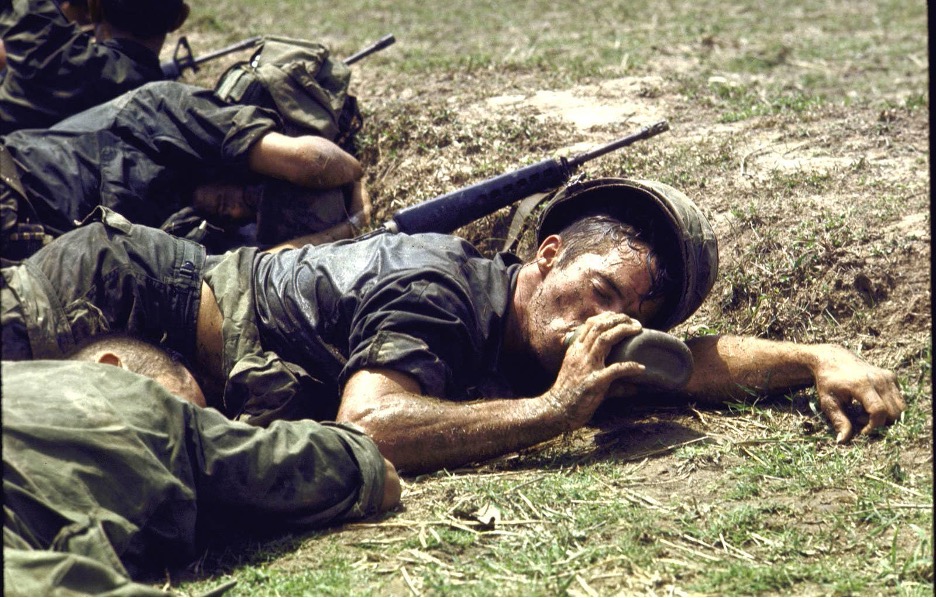
This photo was taken near the Cambodia-Vietnam border in 1970. The exhaustion is palatable through the film.
74. Joy Girls
Moments after firing into a Viet Cong village, US troops remove “joy girls” or women of the night from the area.
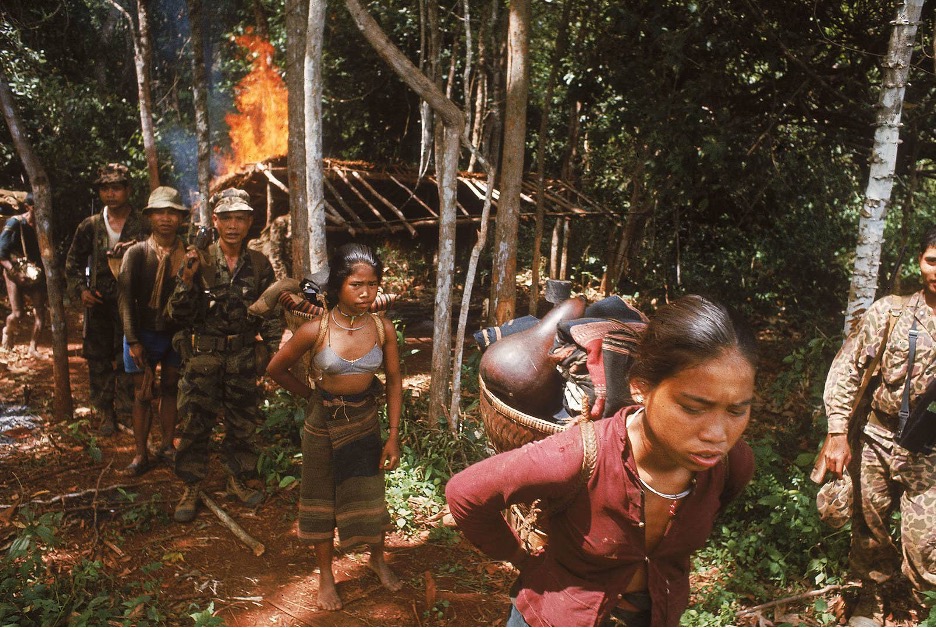
This photo depicts the many nuanced ways the conflict brought about savagery and havoc onto people’s everyday lives.
75. Service Members Pay Respects
War and lost lives go hand in hand, sadly enough. This photo shows service members paying their respects to those who did not make it out of the conflict.
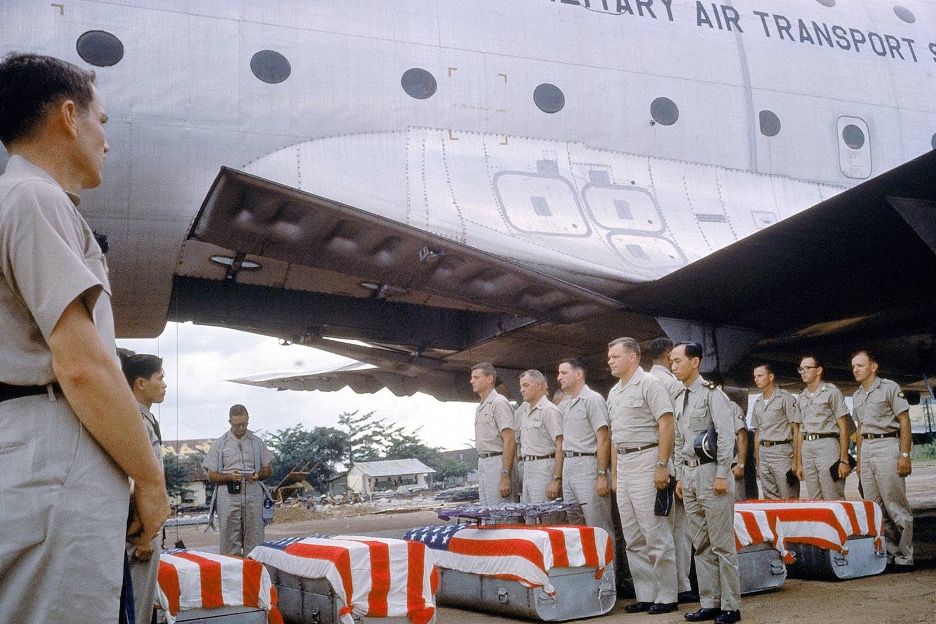
The soldiers line up respectfully near the coffins before military air transport takes them away from the Tan Son Nhut Air Base.
76. Medal for the “American Sniper”
Carlos Hatchcock, Nicknamed “White Feather” due to his always wearing a white feather on his bush hat (taunting the North Vietnamese to spot him), was an iconic sniper during Vietnam.
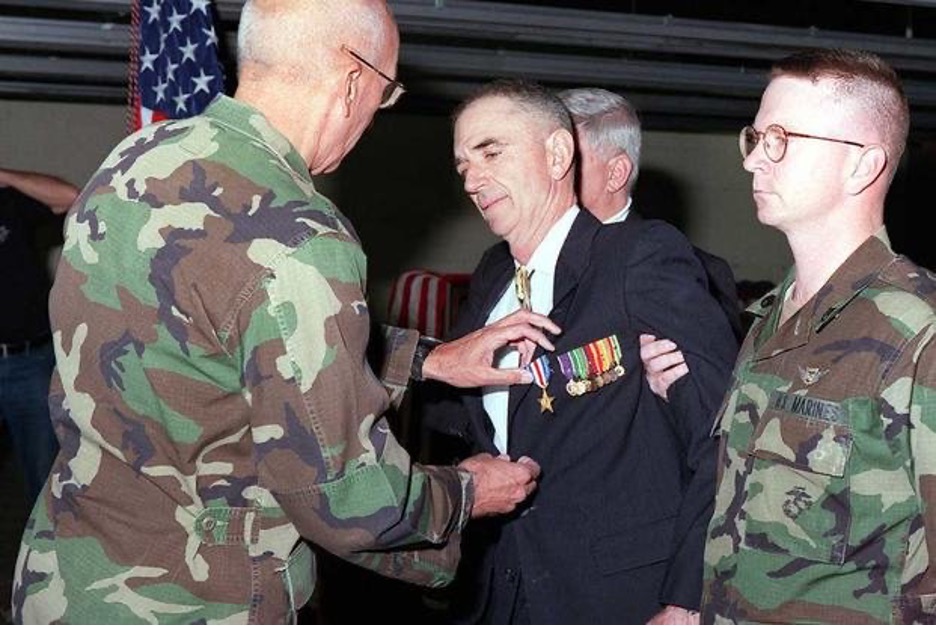
Hatchcock was bestowed the Silver Star during a ceremony at the Weapons Training Battalion. He was given the honor by Lieutenant General P. K. Van Riper.
77. I’m Going Home
It is hard to conceptualize the trials and tribulations of the enlisted men of this brutal conflict. More than likely, the desire to defeat and get home was an overshadowing feeling.
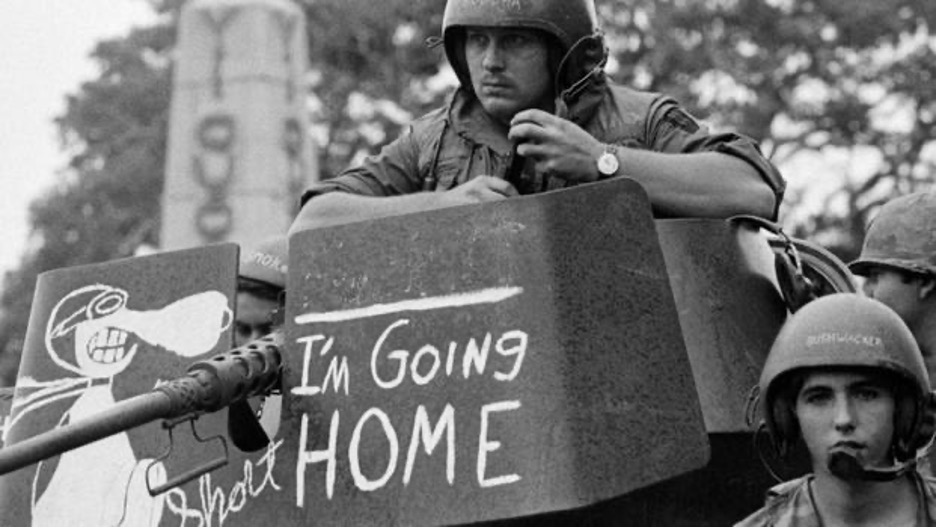
These soldiers adorned their tank with the phrase “I’m Going HOME,” perhaps as an expression of dominance and a need to defeat as a way to get home.
78. Human Kindness
This photo by Don McCullin shows a US corpsman carrying an injured child away from the battle in Hué. The small child was found wandering on the previous night between the North Vietnamese and American firing lines.
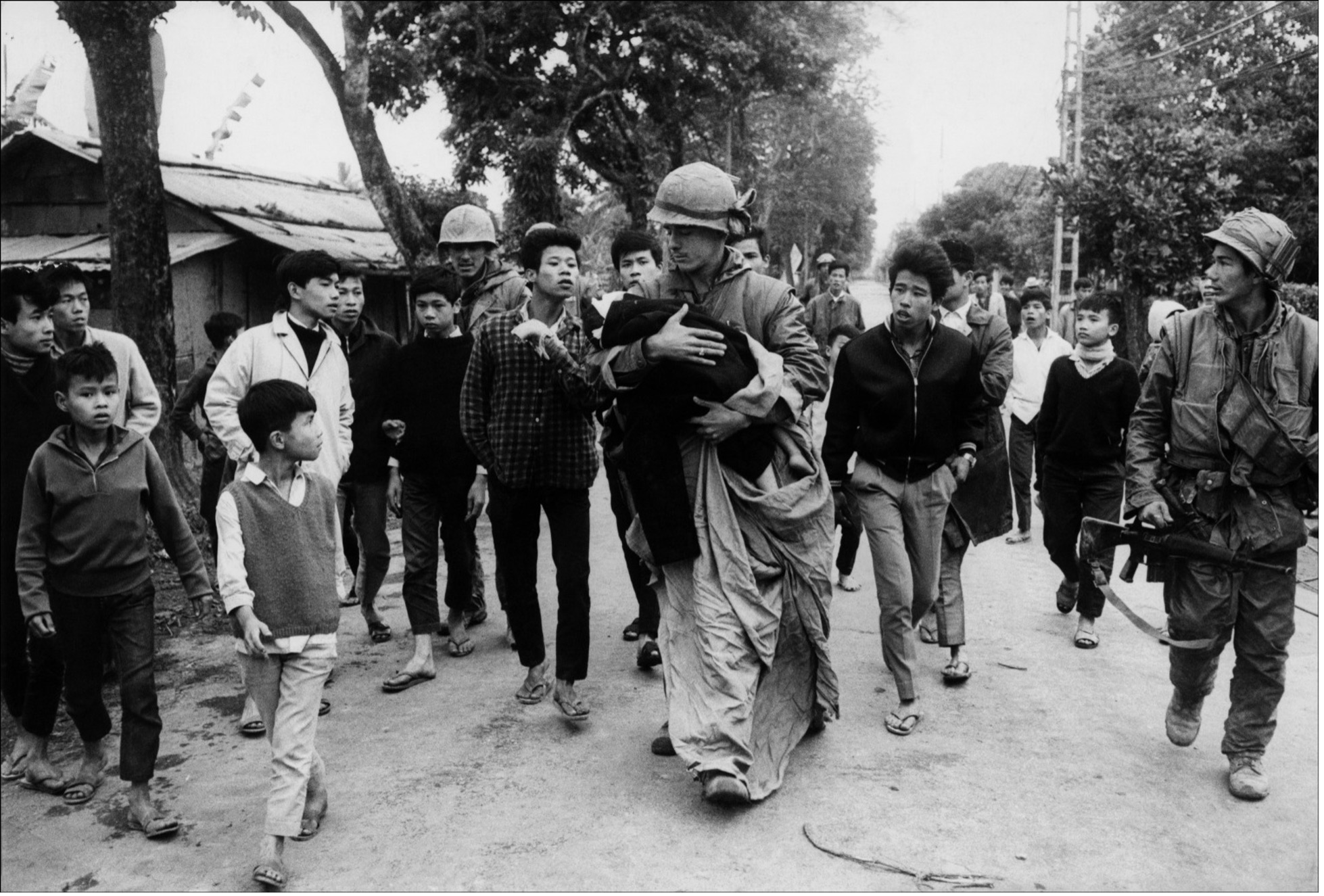
According to Cullin, it was “almost a religious experience” to see the tough marines become so soft and nurturing to the lost child.
79. Tucked In
Tens of thousands of protestors rioted in Chicago amidst the 1968 Democratic National Convention, protesting the conflict in Vietnam.
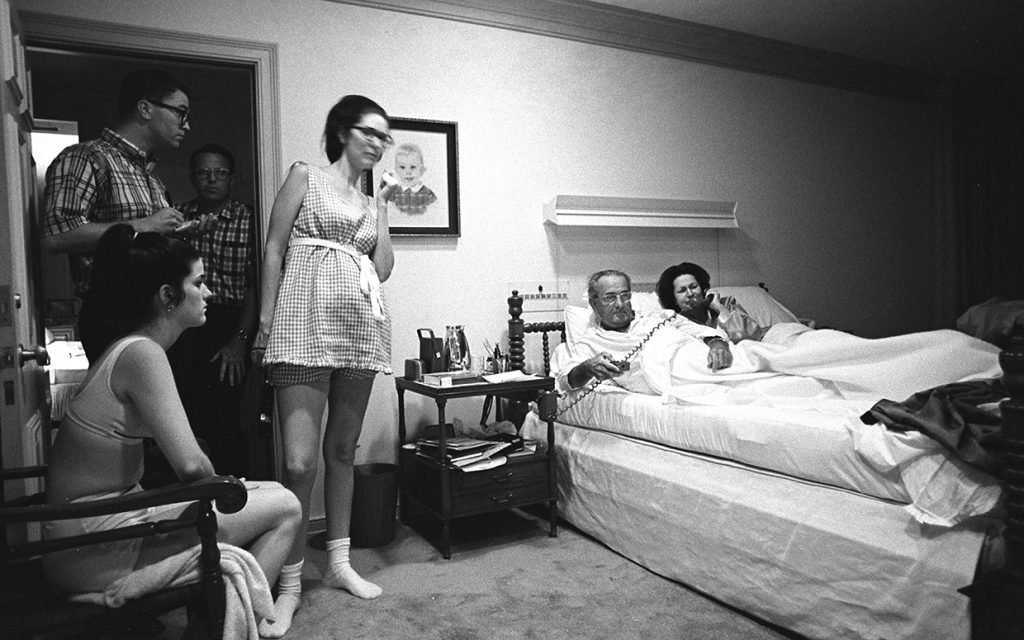
President Johnson and his family watched safely from his bedroom at their ranch in Stonewall, Texas. To be a fly on the wall in that room!
80. Trying to Win Over the Civilians
This photo illuminates the American effort to win over civilians with treats and affection. It is an especially striking photo for its dramatic contrasts in subjects and background.
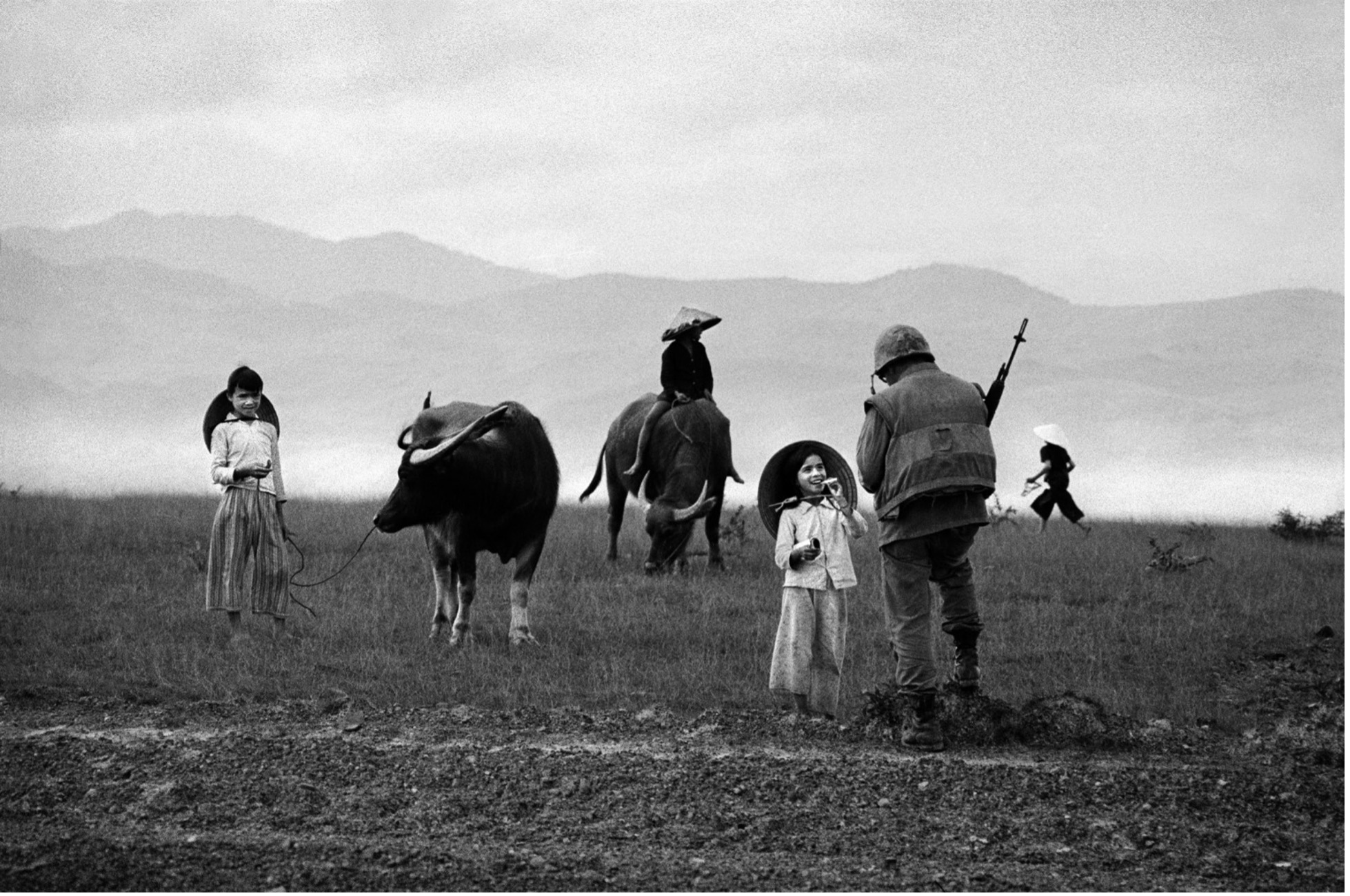
The man with his gun flung over his shoulder looming over a smiling child encapsulates a small piece of humanity in a nation devastated by battle.
81. Burning it All Down
A man from the 1st Cavalry Division throws a rice basket onto the flames after his unit swept through a village near Tam Ky in 1967.
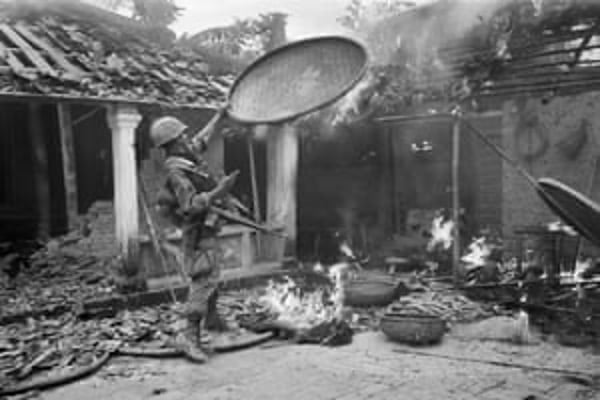
A peasant woman had tried to salvage the basket from the burning house but was unsuccessful. US troops were intent on destroying anything and everything that might have been viewed as valuable to Viet Cong
82. Waiting for Help
A US paratrooper grimaces in pain as he awaits medical evacuation at his base camp near the Laotian border.
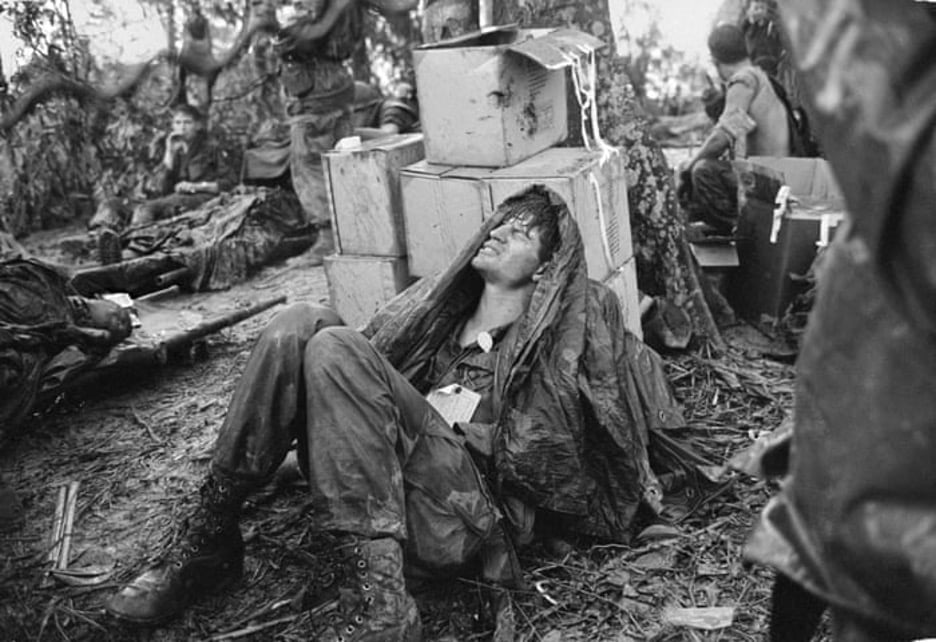
The paratrooper was wounded in the Hamburger Hill battle, on May 19th, 1969. The photo was taken by Hugh Van.
83. The Unsung Heroes
Typically behind the camera, photographer Huynh Thanh My was photographed pinned down with a Vietnamese battalion in a Mekong Delta rice paddy in October 1965.
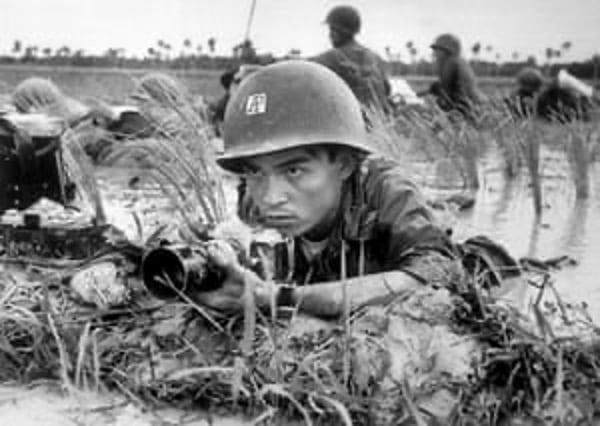
Huynh ultimately passed away about a month later while photographing combat. His brother came to work for the associated press soon after.
84. Clearing Up After the Wreckage
After the United States dropped missiles on top of Vietnamese refugees they are left to pick through the wreckage of their former homes in the city of Hue.
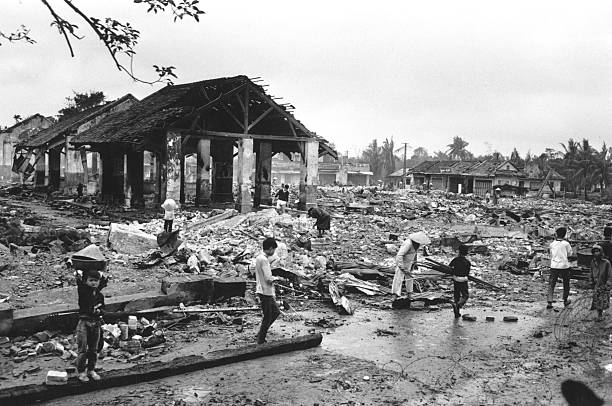
Source: Getty Images
There is a stoicism and pervasive sadness that comes across through the photograph. People left behind in the wake of the ugliness of conflict and depravity.
85. Female Fighters
Female fighters were common on both the North and South side of the Vietnam conflict. In this photo, South Vietnamese women engage in target practice at what looks like a training camp.
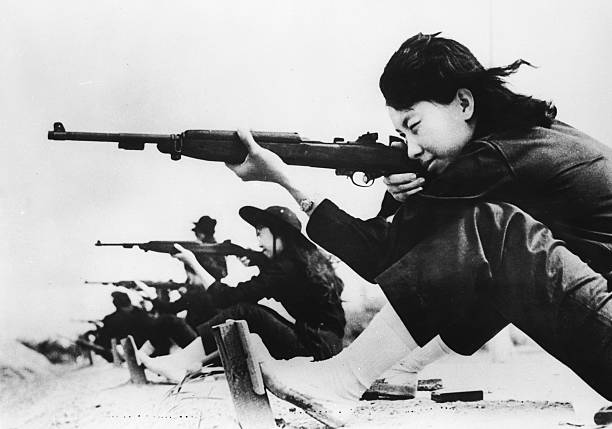
Source: Getty Images
Several million Vietnamese women served, predominantly in the National Liberation Front of South Vietnam (also known as Viet Cong). A common slogan was “when war comes, even the women must fight.”
86. A Downed Helicopter
Children and adults gather around a downed US helicopter that crashed among the streets. The helicopter was destroyed the day before the takeover of Saigon during the evacuation of refugees.
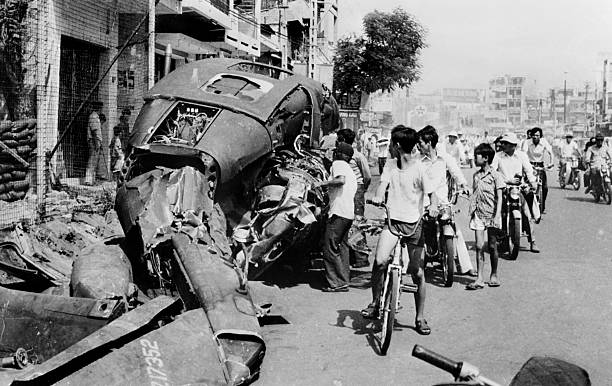
Source: Getty Images
You can see the damage left behind in the buildings it crashed into and the awe of the gathered civilians.
87. Soldier Kneels
A soldier with a rocket launcher kneels as rockets ignite around him. The photograph looks like something out of a movie and is a truly masterful shot.
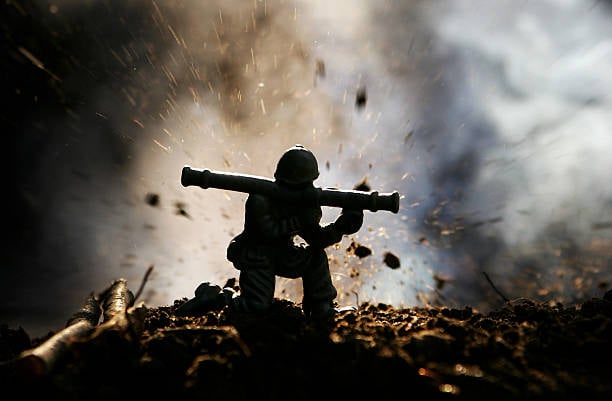
Source: Getty Images
The lighting and color composition is gorgeous, even if the subject matter is less is depicting the atrocities of battle.
88. Still Fostering Hobbies
Even amongst something as intense as combat, soldiers still find time to pass and foster who they were before they were asked to fight.
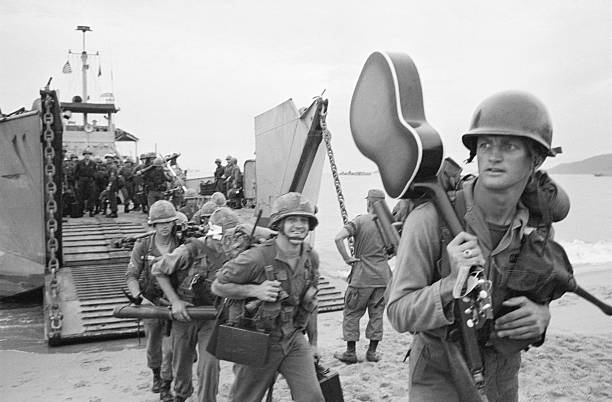
Source: Getty Images
In this photograph, a serviceman slings a guitar over this shoulder as he exits with his comrades. It would likely be painfully beautiful to hear the music of the soldiers in the time of conflict.
89. Intersecting Protests
During the Vietnam Conflict there was a lot of social unrest back in the United States. The dispute went on for twenty years, and in that time Black Americans were trying to get the support of their fellow Americans to combat the structural racism that was still being dismantled.
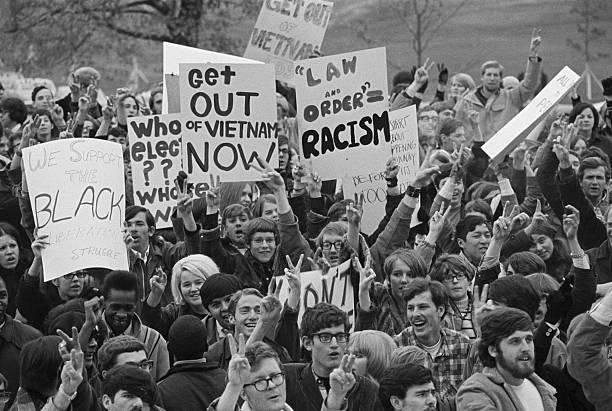
(Original Caption) 11/05/1968-Des Moines, IA- Participants in a Students for a Democratic Society-sponsored demonstration display signs protesting the general election as a "hoax" and calling for peace in Vietnam. The demonstration was staged on the steps of the Iowa capitol building after a three-mile march under police supervision.
At the same time, Black Americans were also fighting with American forces. It created a lot of tension in a conflict already rife with conflicting narratives.
90. A Veteran Remembers
A veteran tours the military graveyard grounds of fallen soldiers of the Vietnam conflict. Seeing the graves in a physical capacity really puts it in perspective.
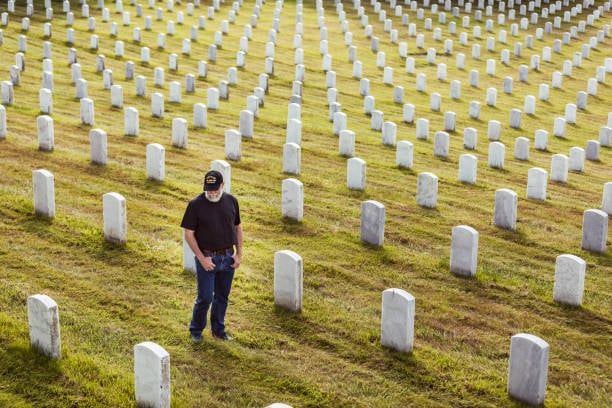
Source: Getty Images
58,220 Americans lost their lives in the conflict by the end of it.
91. Soldiers Waiting to Launch
Here, enlisted men wait casually to launch into the sky for their next mission in the open side door of the grounded Bell UH-1.

Source: Getty Images
It is incredible to see the ease of which they sit in the helicopter, legs strewn over languidly, ready to go high into the sky. For most, it would be nausea-inducing to be so close to the edge and so high in the sky, but these men seem prepared for anything.
92. A Casual Stroll
Some of the more interesting photos from Vietnam are the small moments of simplicity that still take place despite the terrifying background of conflict.
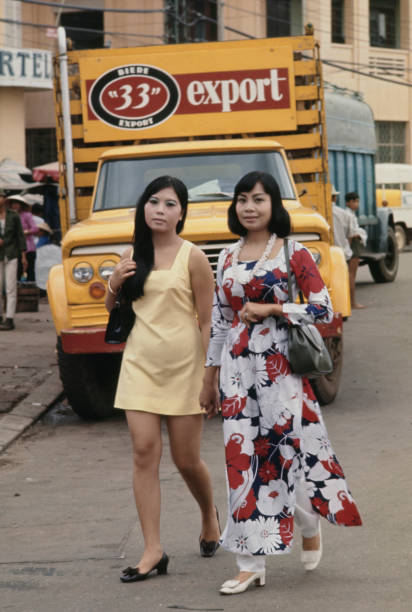
Source: Getty Images
Two women stroll through Saigon, Vietnam in August 1970. They are fashionably dressed and seem to be in good spirits. Following the end of combat, Saigon was officially named Ho Chi Minh City.
93. Who is the Real Enemy?
Here is a portrait of anti-Vietnam combat protestors with a sign near the Lincoln Memorial during the March on the Pentagon demonstration.
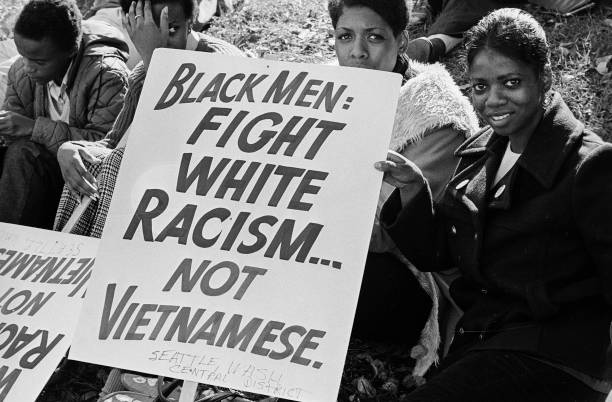
Source: Getty Images
This took place in Washington DC, on October 21, 1967. The sign reads ‘Black Men, Fight White Racism Not Vietnamese.’
94. Soldiers with Women
Many Vietnamese women served in the military alongside their male counterparts, making a huge impact on the war. Other women served in a different way.
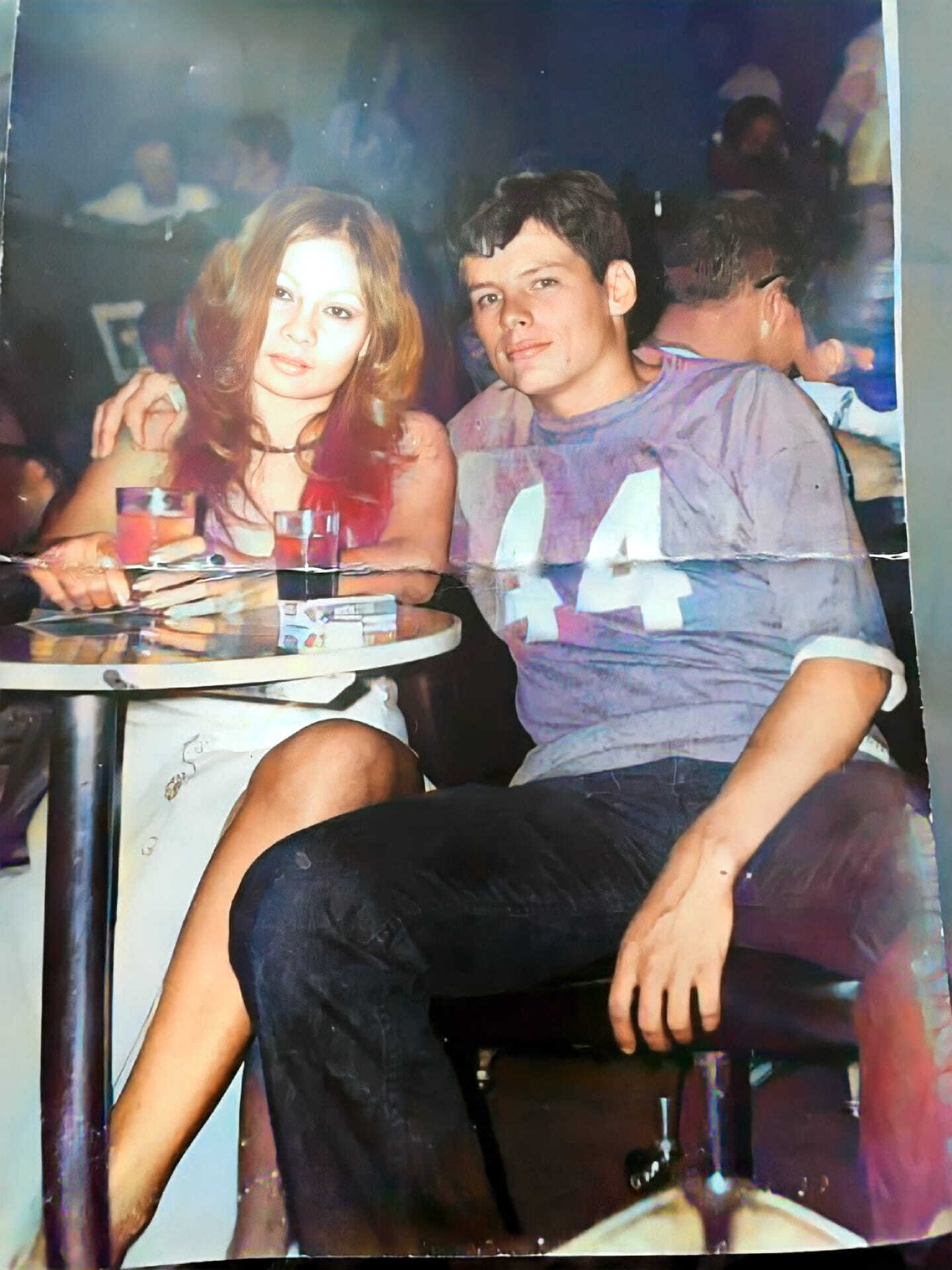
Some women found employment as a hooch maid. They were to clean the American soldiers’ quarters. Women also had to step into more active home and agricultural duties while their husbands, fathers, or brothers were in combat.
95. What Women Wore
While the Vietnam War inspired the Hippie movement and relaxed style in the United States, style was very different in Vietnam. If women were not wearing the traditional Ao Dai style dress, they could be seen in this kind of attire.
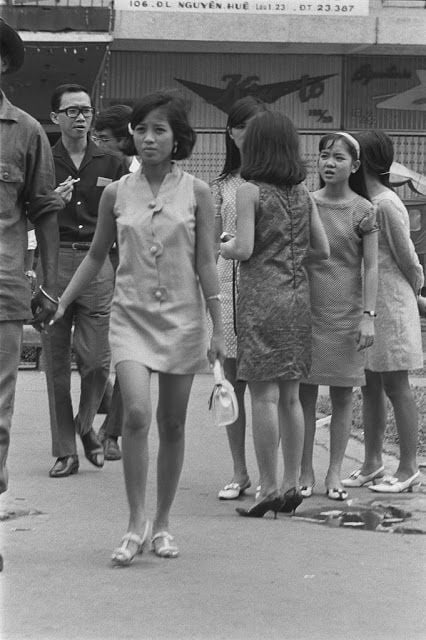
Somewhat modest dresses and small heels with headbands or clips were all the rage for Vietnamese women. Women were expected to dress presentable even in wartime.
96. Female Warriors
Women were involved on both sides of the war. They were often soldiers, nurses, and journalists on the battlefield. It is estimated that about 11,000 military women served in the Vietnam conflict.
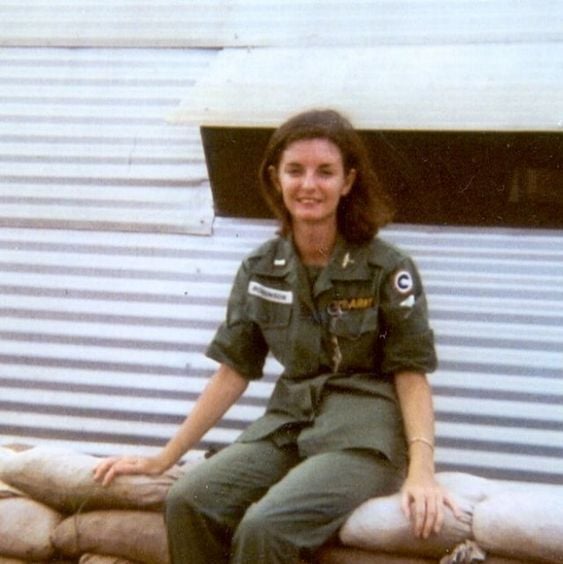
All of the women that served were volunteers. Many came in as nurses, but a lot of women fought in battle alongside the men as well.
97. Nurses in Conflict
Many women volunteered as a part of the Red Cross organization. The women who served as nurses in the conflict were integral to the battle. The American women stationed in South Vietnam helped train South Vietnamese women in nursing skills.
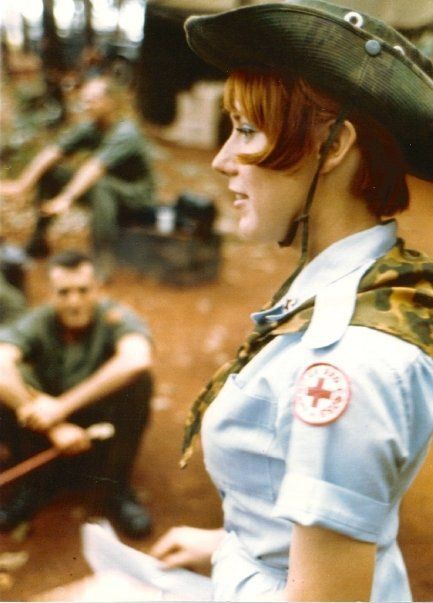
These women were anywhere from in their early 20s to late 40s. They trained more than 5,000 Vietnamese women who served in the conflict as health care aids.
98. Music During the Vietnam War
The conflict in Vietnam caused a boom in music in the U.S. after the war. The impact on art from the war is widely studied, but the music that came from Vietnam is less examined.
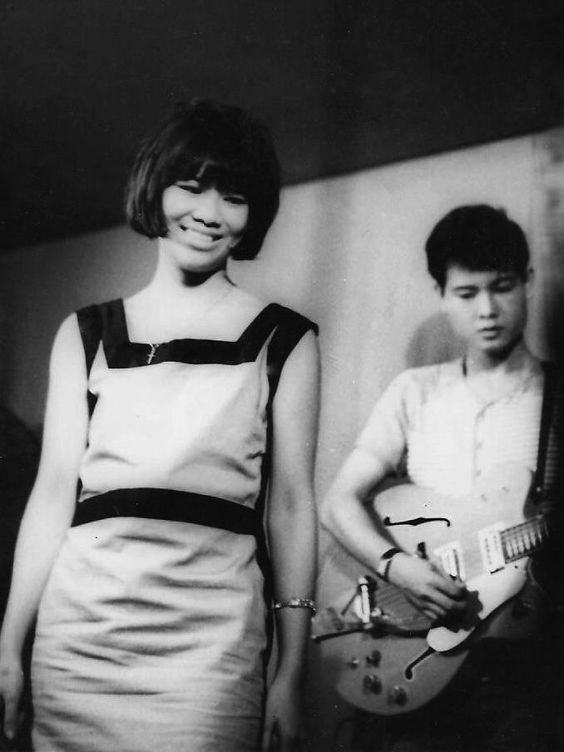
The music that came from North Vietnam, SouthVietnam, and the United States reveals a lot about the conflict and the differences in politics between the regions at war. Music was used to lift spirits as well as encompass the tragedies that were happening.
99. Vietnamese War Brides
It was not uncommon for American soldiers to marry Vietnamese women while they were stationed there. Over 8,000 Vietnamese women came to the United States as a result of becoming “war brides” between 1964 and 1975.
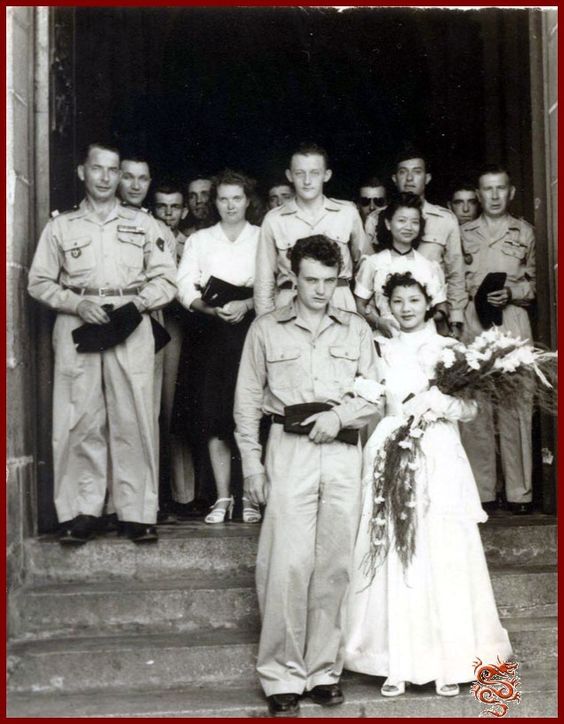
Marriages also increased as the war began to end. The term “war brides” was coined in World War I and became more popular during and after World War II.
100. More Marriages
This is another example of a young South Vietnamese woman who married an American soldier during the war. This image was taken in September of 1970, 5 years before the conflict ended.
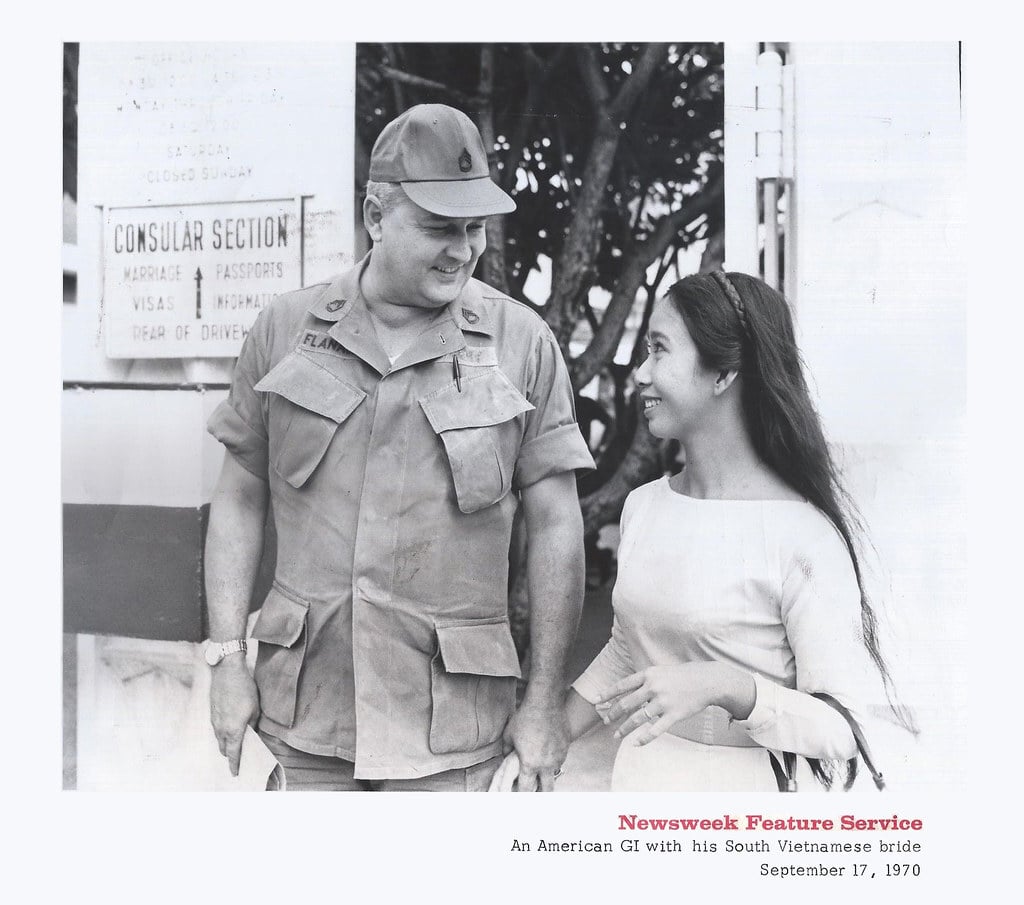
Source: flickr
They were also commonly referred to as GI brides because American soldiers were referred to as GIs at the time.
101. Bar Girls
In the midst of conflict, the sex industry sprang into action. Female prostitutes would hang out at bars in which soldiers would frequent and offer their services. Thus, they became known as “bar girls”.
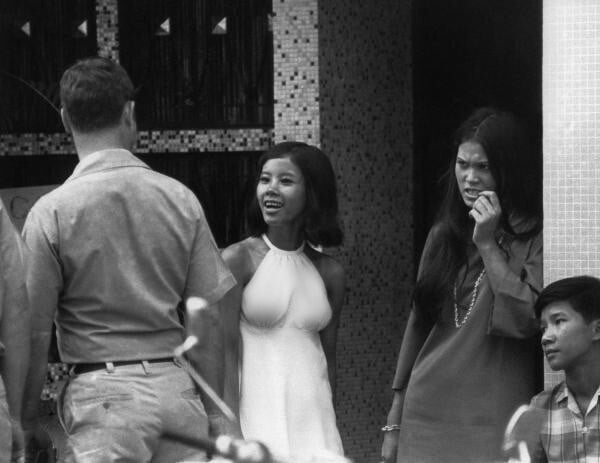
Occasionally, hooch maids would also offer private services to American soldiers while they were cleaning their homes. These “services” resulted in many unwanted children who were later forced into the sex industry themselves.
